#whoever actually can draw - feel free to utilize this concept
Text

So needless to say
I'm odds and ends
But I'll be stumblin' away
Slowly learnin' that life is okay

#take on me#take me on#these are objectively not good but it won't leave my head until I do smthn about it#whoever actually can draw - feel free to utilize this concept#the steddiefication of everything#steddie art#steddie#steve harrington#eddie munson#stranger things art#joe keery#joseph quinn#stranger things
106 notes
·
View notes
Text
Intentions + Money
I have been doing a lot of work on things through therapy and just personally, and one of the questions I keep coming back to is ‘what are my intentions’. A lot of self-help blogs and books and life-purpose-type articles push the narrative that you need to ‘find your why’. I don’t necessarily agree with that, and I definitely don’t agree with that for everyone, but it did lead me to want to ask other questions about myself. My Intentions seem more purposeful than a ‘why’. A ‘Why’ feels a lot like I’m leaving something up to God or Fate or All-powerful-Universe whereas an Intention is a decision I’ve made and the impact that I hope I will make with that decision.
We don’t all get to live our dreams. I wanted to be a famous actor, I wanted to be secure in a home, and I wanted to have published so many books by now. But, I have a hard time coming up with original concepts, I do not have a face for movies (until I get old, then I’ll probably be ‘that old person who was in a hundred things for five seconds at a time) and I’m in a very unsteady living situation. I’m in a job I can’t stand. But, I’ve come to this realization that, moving forward with careful consideration and intention, I can still shape this into something that hopefully I’ll enjoy. At least for the five more years we have before Jeff Bezos blows up the planet or we hurdle into the sun or whatever is going to happen.
I have a lot of ‘Intentions’ that I use when creating the art that I choose to create. My Intention with my YouTube videos is to share my knowledge of sewing and crafting because I have a lot of it. At one point, I tried to monetize that by selling project tutorials and it made me miserable, but I’ve also been in so many situations in the last decade where I haven’t been able to buy patterns or buy fabric or buy something that I just decided I wanted to offer this information FREE to whoever wanted it. Would I like to be monetized on YouTube? Eh. I feel like that gives YouTube too much of a say over what I’m doing and what I make. I do have a Kofi, but honestly, I want people to see and like my videos. I am an actor. I enjoy the audience experience. And I want people to see the joy I have in making things and potentially be inspired to make things of their own. That is why I make videos.
The Intentions I had when I decided to get heavily into posting Fanfic last year were pretty depressing. I work in medical offices. I was sure I was going to die- I still have fears of catching COVID from one of our patients. But I am also fairly poor and between all the subscriptions, all the websites shipping things to homes, I just wanted to offer up free entertainment to try and cheer people up. I’m not conceited enough to think I made a huge difference to anyone’s life, but in my limited silverware drawer, it was the thing I had enough spoons to do. So there were my Intentions- give myself a purpose, give something entertaining that was free because I can empathize with not being able to purchase or subscribe or give tips, and to leave something of myself behind if anything happened during the pandemic.
You don’t need to know all of my intentions, but you should probably know that this is coming from a lifetime of money dictating my art and my rebellion against that. I used to find joy in painting on jackets and jeans. The Dreaded Ex detested my style and bought me canvases, only to complain when I didn’t paint on the canvases and, after a little while, didn’t paint at all. That same Ex, the one that made me too nervous to enter book stores, would pressure me about reading ‘real books’ and get frustrated and upset when I read fanfiction. He would set his writer friend on me to give up writing fanfiction and write ‘things that were worth my time’ until I finally took a long hiatus from writing at all. But he had bought the canvases, he had purchased the books- the money gave him ownership of me and what I could and could not creatively do. There’s more nuance to the argument, and I’m not trying to make him sound like some Big Bad Monster, because I live with me, I know I’m pretty fucking horrible, but there were real moments of ‘but I bought you that so you should’.
It’s why I didn’t enjoy art school. It was an entire two years of people trying to mold me into a Fine Artist when all I wanted to do was draw cartoons. So my talents could be marketable as a graphic designer or something useful to make money. Make money out of your art.
I want to live in a world where the Fic that I write can be attached to my face. I want to be able to be proud of the fact that I wrote an homage to someone and I don’t want anything more than the comments and kudos from people that enjoy it. I don’t want to be nervous that I’m going to get C&D’d for being proud of something I wrote just because I don’t own the characters. I want to give my stuff away because I’m just so sick of being told what to do. In real life, I’m told I’m horrible over and over and over. I have a bad voice, I have a mean face, I have too many questions, I have too short of a temper - - I had a job tell me that I walked too hard. Two jobs, actually, have told me that I walk too hard. “Sounds like a herd of elephants”. And you have to shut up and take it because they pay you to be there, they pay you to smile and sound nice even when you don’t want to.
So my intention is that my art needs to stay pretty free. That’s why I have a Kofi and not a Patreon- you can tip me if you want to, but I try really hard not to care about that. And I can promise, I will never utilize Post+ on Tumblr.
7 notes
·
View notes
Text
9 Steps to Creating a Landing Page That Reads Your Prospects’ Minds
So you’ve decided to create a landing page to promote your new product or service.
But how do you know if your landing page will convince your readers to convert?
There are a number of things you can do to ensure your readers are enticed by your landing page and want to know more information.
In this post, we’re going to figure out exactly what you need to do to produce a mind-reading landing page. But first, let’s start with the basics.
What is a landing page?
Before you create a landing page, you need to understand exactly what it is.
A landing page is a dedicated web page, often called a squeeze or splash page. The objective is to collect your visitor’s data through a lead capture form.
You might use a landing page to give away a free e-book, webinar, or course in exchange for your audience signing up for your email list.
Or maybe you collect emails before launching your new website.
The best part about a landing page is that it’s only one page.
It’s one page you need to optimize.
Why, then, do so many people make mistakes with their landing pages?
And why do so many people struggle to convert their customers?
A well-crafted landing page will enable you to target a specific audience, create a compelling message, and increase conversions.
But what goes into creating an effective one?
What makes some landing pages successful and some fall flat on their face?
It all comes down to whether you know your audience or not.
Those who know their audience will be able to create the right messaging, hold their audience’s attention, and come up with a mind-reading landing page.
But just how do you do that?
Let’s find out.
1. Create a persona
It all begins with creating your ideal persona. When you know who you’re targeting, you will be better equipped to create a landing page that resonates with them.
Your personas should be your ideal target audience. After all, if the right people aren’t visiting your landing page, you will never convert in the first place.
Your personas should include demographic information like where they live, their ages, and their genders.
But they should go further than that.
If you want to create a mind-reading landing page, you need to know what inspires your ideal personas and what they hope to achieve.
You must find out their opinions and how they feel towards specific ideas.
When you do this, you’ll able to position your offer to them so that it’s irresistible.
Buffer uses personas to connect with their target customers.
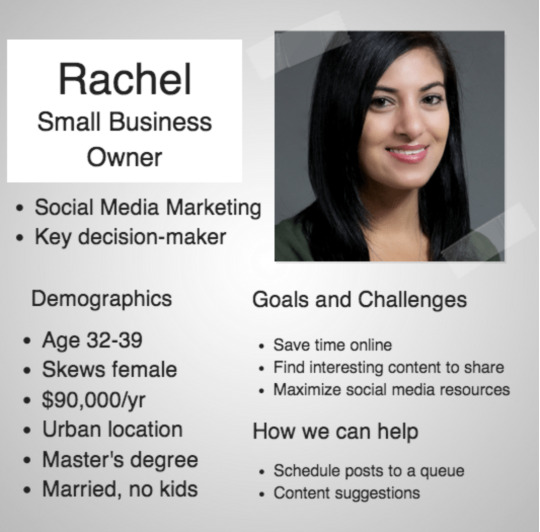
Using the information they’ve put together here, they will have a greater understanding of how to create their landing page.
You want to increase your chance of conversion, so don’t try to make your landing page appeal to absolutely everyone.
Instead, use the data in your personas to produce highly-targeted landing pages that speak to a specific group of people.
You only have a few moments to grab your visitor’s attention. And in those short few moments, they’ll decide whether or not they want to convert.
2. Present the offer
The reason landing pages are so effective is that they isolate the action.
There shouldn’t be a menu or other links on the landing page. It should all guide the visitor toward completing the action you want them to take.
Distracting them with multiple options is a surefire way to confuse them. Your conversion rate will suffer.
Do not give your visitors a choice. Make it clear what you want them to do.
The only option they should have is to convert or not to convert, like in this example from Geico:

The clear landing page means that whoever lands on the page only has one option. Enter their zip code or not.
But just making the chosen action clear isn’t enough to ensure that your visitors convert.
You need to create an offer that resonates with them enough to take the action.
Think about it. A landing page that asks its users to sign up for the newsletter in exchange for nothing isn’t going to convert very well.
Why?
Because there’s no incentive. Why should your visitor do anything for you without getting something in return?
And no, your newsletter alone is not enough of an incentive.
But creating a compelling offer doesn’t have to be a complicated task. You just need to provide your audience something they actually want.
Autopilot knows their readers would be interested in growing revenue with Instapage, so a replay of the webinar would be beneficial to them.

This is a good example of a strong offer.
If you already have a landing page that you’re looking to improve, ask yourself whether or not as a visitor you would take the desired action.
If the answer is no, then there are changes you need to make.
If you’re struggling to create an offer, but you know you want to build your email list with a landing page, then look at your most popular piece of content.
We can see here that the most popular piece of content on my blog is [enter content].
If you were to offer this content as a downloadable PDF or checklist, people would be likely to give you their email address in exchange.
Why?
Because you already know it performs well. You have proof there’s a need for it.
Here, the hard work is done for you. Find a popular piece of content, find a way to repackage it as a downloadable piece, and offer it to your audience.
But what if your landing page isn’t for an e-book, checklist, or downloadable PDF?
Think about other ways you can provide value to your audience.
3. Write the headline
Once you’ve got your offer down, you need to start working on the headline. The headline must be captivating.
It’s usually the first thing your visitor will see, so you need to perfect it.
youtube
The headline is often the deciding factor of whether or not a visitor will convert. And you only have one real opportunity to make it work.
Your headline should be driven by the benefits. You need to outline exactly what will happen to the visitor once they take your desired action.
Capital One makes use of both a heading a subheading to get their point across:
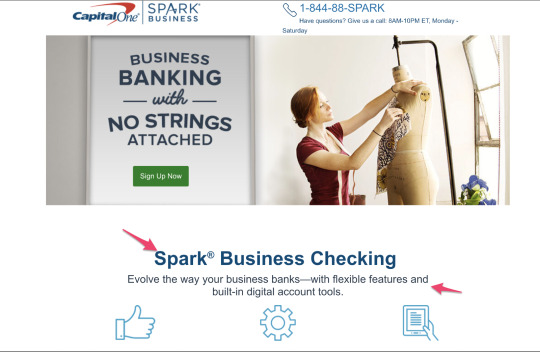
They know people who are interested in their service are going to want to have their business in order, so they position their offer in that sequence.
Salesforce has a clear headline and message:

This headline is great because it grabs the audience’s attention. They’re immediately drawn to it. Visitors automatically know what will happen if they fill in the form on the right.
Joanna Wiebe of Copy Hackers says if you’re struggling to find the right words, then look at the language your audience uses.
Why is this effective?
Because if you use your audience’s own language in your headline, it will resonate better with them.
After the headline, you’re likely going to use a subheading.
This is another opportunity to mention the benefits. It’s for people who were compelled by the headline but need some more convincing.
It gives you another chance to keep their attention and draw them closer to your call to action.
4. Create the copy
Good copy sells. You know that. It’s why some companies pay copywriters thousands to put words on a page.
But it’s not as easy as just writing words on a page. They have to mean something to your target customer.
As we mentioned with the headline, if you’re struggling to find words, then utilize the language your prospects use.
Your copy is there as a tool to help you get your point and message across and increase the chance of conversion.
It all begins with finding the sweet spot for the right amount of copy. Write too little and you won’t have enough words to get your point across. But write too much and the page will become overwhelming.
However, just saying “find the sweet spot” doesn’t help you.
In general terms, the amount you write depends on the offer. For things that need a lot of explaining and persuading, you’re going to need more copy.
For things that require the prospect to provide you with more than just their email address, i.e. when they are making a purchase, you are naturally going to need to use additional copy to ensure all the necessary details are there.
When it comes to actually writing your copy, you should mirror your brand’s style.
Keep in mind that it’s not about you. It’s about the customer, so the phrasing you use should be customer-centric and focus on them.
Evernote personalizes their landing page copy by avoiding using words like “we” or “our” and instead opts for words like “your” and “you”:

These words highlight to your prospects that the main reason for this landing page (and your business) is to help them solve their problems.
5. Use visual aids
Like we said, your landing page is only one page, so everything should be there for a reason and have a purpose. The same rule applies to any images or videos you use.
When you’re adding images to your landing page, you should utilize ones that help your visitors visualize their life after they’ve taken your action.
Airbnb is a business that focuses on people. So it makes sense that they should use images of people on their landing page:
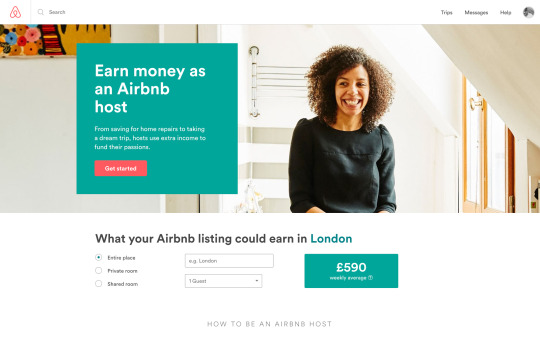
They want their users to feel accomplished and happy if they sign up as an Airbnb host, so they include an image of a woman smiling.
For anyone thinking about signing up for the Airbnb platform, seeing an image like this will encourage them it’s a good idea.
Shopify, an e-commerce platform, uses images to show visitors how their shop could look:
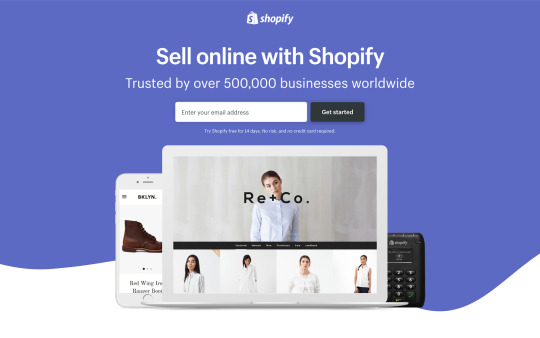
You can utilize images to guide your audience towards the call to action.
The images make your offer more human.
Your audience cannot touch or hold your product. Your landing page should make use of images to help them visualize it.
6. Include social proof
When creating a mind-reading landing page, understand that one question your audience will have is, “Do I need this?”
This is true for every landing page.
One way to read their minds is to address their question through the concept of social proof.
People are more inclined to take action if they know other people just like them have taken action and benefited from it.
Using social proof on your landing page provides prospects with another layer of trust. They feel like it’s more likely your product/service will actually do what you say it will because they can see what other people thought about it.
For example, check out what Freshdesk does on their landing page:
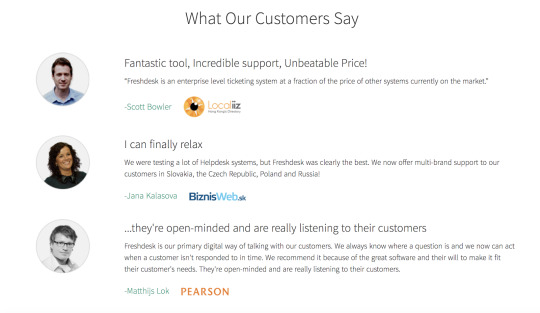
Do you have reviews and testimonials for your product you can use on the landing page?
Visitors get to experience how their life could be different from signing up. And they learn that from other people just like them.
7. Utilize a call to action
Your call to action button is important. It’s perhaps the most important element on the page.
If your audience can’t see your button clearly, they’re not going to know what to do.
Each landing page should have a call to action. The call to action is there to guide your user’s attention.
Let’s talk about your call to action button copy.
Your button copy should be action driven and relate to the offer available.
“Download” copy on the call to action is vague, and the visitor might not even remember what it is they’re downloading.
Take a look at the call to action button on Hired. It stands out as the only red button on the page:
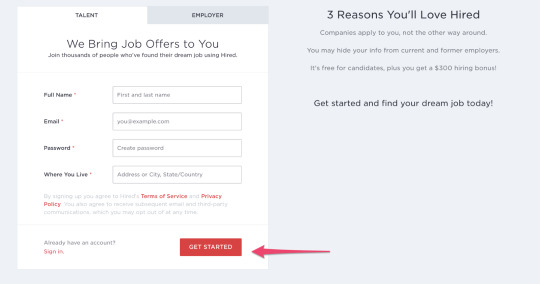
Alexa uses the “Try 7 days free” copy, which takes the pressure off the visitor. They don’t have to fully commit to using the service, and won’t be charged if they’re not happy with it:
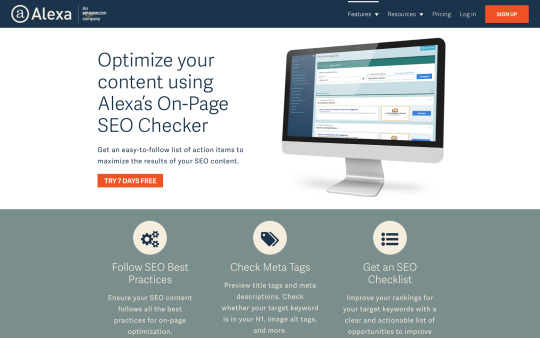
Both Hired and Alexa use excited copy like “Get started.” Using the word “get” psychologically makes people feel as though they are getting something in return for giving you their details.
8. Measure your results
If you don’t measure the results of your landing page, you have no real way of understanding whether or not it is converting successfully.
Use Google Analytics to measure how many visitors came to your landing page and converted by giving you their data.
When looking at the effectiveness of your landing page, consider your bounce rate.
Your bounce rate is the number of people who landed on your landing page and didn’t convert.
If your bounce rate is low it could mean one of the following things:
You aren’t using the right keywords. Your keywords should be relevant to the audience you want to attract. If not, you will have a bunch of untargeted prospects coming to your site with no interest in what you’re offering.
The design on your landing page is poor. Consider how often the average person spends on your landing page. If it doesn’t follow a logical flow or is too confusing, they’re more than likely going to bounce.
9. Make sure you test
The only way to know if your attempts are working is to run tests.
A/B testing your landing page involves splitting your traffic in half, so half the traffic sees one version of the landing page and the other half sees another.
This way you will be able to make informed decisions about what does and doesn’t work.
You can compare two versions of your landing page and test different elements.
Do you have two headlines you want to use, but you aren’t sure which will work best? Use A/B testing.
Then after you’ve generated enough traffic, you’ll be able to see which led to the highest number of conversions.
With this data, you can continually improve your landing page to ensure it converts the most people.
When testing elements, don’t try and test everything all at once. If you do this, you’ll have no clear idea what you need to change and what you need to keep the same.
Instead, change a few elements at a time and keep the other elements the same as a control variable.
Conclusion
Your landing page has one job, and one job only: To convert.
So why are you not doing everything you can to encourage your visitors to take your desired action?
It all begins with planning.
But the planning begins even before you start thinking about what you will have on your landing page.
If you want it to be successful, you have to read your prospects’ minds.
Essentially, you need to know your customers really well.
Once you know them, you’ll determine what words, images, and reasoning resonate most with them.
And once you start using their own ideas on your landing pages, your conversion rates are going to increase.
But, with everything in marketing, there is no one size fits all.
Follow the best practices listed in this post and develop your understanding of your audience, and you’ll be able to create winning landing pages for all your offers.
What strategies do you use to improve your landing pages?
The post 9 Steps to Creating a Landing Page That Reads Your Prospects’ Minds appeared first on Neil Patel.
Original content source: https://neilpatel.com/blog/mind-reading-landing-page/ via https://neilpatel.com
The original post, 9 Steps to Creating a Landing Page That Reads Your Prospects’ Minds, has been shared from https://imtrainingparadise.wordpress.com/2020/07/06/9-steps-to-creating-a-landing-page-that-reads-your-prospects-minds/ via https://imtrainingparadise.wordpress.com
0 notes
Text
9 Steps to Creating a Landing Page That Reads Your Prospects’ Minds
So you’ve decided to create a landing page to promote your new product or service.
But how do you know if your landing page will convince your readers to convert?
There are a number of things you can do to ensure your readers are enticed by your landing page and want to know more information.
In this post, we’re going to figure out exactly what you need to do to produce a mind-reading landing page. But first, let’s start with the basics.
What is a landing page?
Before you create a landing page, you need to understand exactly what it is.
A landing page is a dedicated web page, often called a squeeze or splash page. The objective is to collect your visitor’s data through a lead capture form.
You might use a landing page to give away a free e-book, webinar, or course in exchange for your audience signing up for your email list.
Or maybe you collect emails before launching your new website.
The best part about a landing page is that it’s only one page.
It’s one page you need to optimize.
Why, then, do so many people make mistakes with their landing pages?
And why do so many people struggle to convert their customers?
A well-crafted landing page will enable you to target a specific audience, create a compelling message, and increase conversions.
But what goes into creating an effective one?
What makes some landing pages successful and some fall flat on their face?
It all comes down to whether you know your audience or not.
Those who know their audience will be able to create the right messaging, hold their audience’s attention, and come up with a mind-reading landing page.
But just how do you do that?
Let’s find out.
1. Create a persona
It all begins with creating your ideal persona. When you know who you’re targeting, you will be better equipped to create a landing page that resonates with them.
Your personas should be your ideal target audience. After all, if the right people aren’t visiting your landing page, you will never convert in the first place.
Your personas should include demographic information like where they live, their ages, and their genders.
But they should go further than that.
If you want to create a mind-reading landing page, you need to know what inspires your ideal personas and what they hope to achieve.
You must find out their opinions and how they feel towards specific ideas.
When you do this, you’ll able to position your offer to them so that it’s irresistible.
Buffer uses personas to connect with their target customers.

Using the information they’ve put together here, they will have a greater understanding of how to create their landing page.
You want to increase your chance of conversion, so don’t try to make your landing page appeal to absolutely everyone.
Instead, use the data in your personas to produce highly-targeted landing pages that speak to a specific group of people.
You only have a few moments to grab your visitor’s attention. And in those short few moments, they’ll decide whether or not they want to convert.
2. Present the offer
The reason landing pages are so effective is that they isolate the action.
There shouldn’t be a menu or other links on the landing page. It should all guide the visitor toward completing the action you want them to take.
Distracting them with multiple options is a surefire way to confuse them. Your conversion rate will suffer.
Do not give your visitors a choice. Make it clear what you want them to do.
The only option they should have is to convert or not to convert, like in this example from Geico:
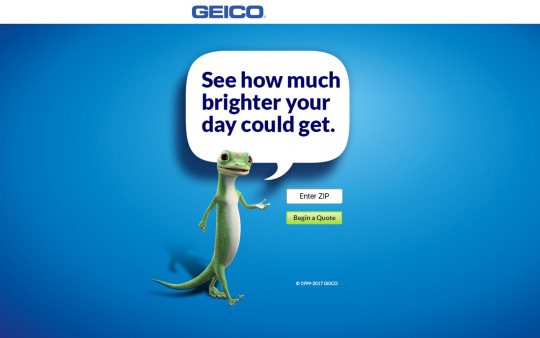
The clear landing page means that whoever lands on the page only has one option. Enter their zip code or not.
But just making the chosen action clear isn’t enough to ensure that your visitors convert.
You need to create an offer that resonates with them enough to take the action.
Think about it. A landing page that asks its users to sign up for the newsletter in exchange for nothing isn’t going to convert very well.
Why?
Because there’s no incentive. Why should your visitor do anything for you without getting something in return?
And no, your newsletter alone is not enough of an incentive.
But creating a compelling offer doesn’t have to be a complicated task. You just need to provide your audience something they actually want.
Autopilot knows their readers would be interested in growing revenue with Instapage, so a replay of the webinar would be beneficial to them.
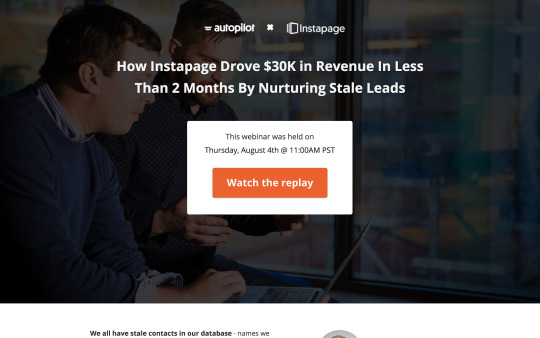
This is a good example of a strong offer.
If you already have a landing page that you’re looking to improve, ask yourself whether or not as a visitor you would take the desired action.
If the answer is no, then there are changes you need to make.
If you’re struggling to create an offer, but you know you want to build your email list with a landing page, then look at your most popular piece of content.
We can see here that the most popular piece of content on my blog is [enter content].
If you were to offer this content as a downloadable PDF or checklist, people would be likely to give you their email address in exchange.
Why?
Because you already know it performs well. You have proof there’s a need for it.
Here, the hard work is done for you. Find a popular piece of content, find a way to repackage it as a downloadable piece, and offer it to your audience.
But what if your landing page isn’t for an e-book, checklist, or downloadable PDF?
Think about other ways you can provide value to your audience.
3. Write the headline
Once you’ve got your offer down, you need to start working on the headline. The headline must be captivating.
It’s usually the first thing your visitor will see, so you need to perfect it.
youtube
The headline is often the deciding factor of whether or not a visitor will convert. And you only have one real opportunity to make it work.
Your headline should be driven by the benefits. You need to outline exactly what will happen to the visitor once they take your desired action.
Capital One makes use of both a heading a subheading to get their point across:

They know people who are interested in their service are going to want to have their business in order, so they position their offer in that sequence.
Salesforce has a clear headline and message:

This headline is great because it grabs the audience’s attention. They’re immediately drawn to it. Visitors automatically know what will happen if they fill in the form on the right.
Joanna Wiebe of Copy Hackers says if you’re struggling to find the right words, then look at the language your audience uses.
Why is this effective?
Because if you use your audience’s own language in your headline, it will resonate better with them.
After the headline, you’re likely going to use a subheading.
This is another opportunity to mention the benefits. It’s for people who were compelled by the headline but need some more convincing.
It gives you another chance to keep their attention and draw them closer to your call to action.
4. Create the copy
Good copy sells. You know that. It’s why some companies pay copywriters thousands to put words on a page.
But it’s not as easy as just writing words on a page. They have to mean something to your target customer.
As we mentioned with the headline, if you’re struggling to find words, then utilize the language your prospects use.
Your copy is there as a tool to help you get your point and message across and increase the chance of conversion.
It all begins with finding the sweet spot for the right amount of copy. Write too little and you won’t have enough words to get your point across. But write too much and the page will become overwhelming.
However, just saying “find the sweet spot” doesn’t help you.
In general terms, the amount you write depends on the offer. For things that need a lot of explaining and persuading, you’re going to need more copy.
For things that require the prospect to provide you with more than just their email address, i.e. when they are making a purchase, you are naturally going to need to use additional copy to ensure all the necessary details are there.
When it comes to actually writing your copy, you should mirror your brand’s style.
Keep in mind that it’s not about you. It’s about the customer, so the phrasing you use should be customer-centric and focus on them.
Evernote personalizes their landing page copy by avoiding using words like “we” or “our” and instead opts for words like “your” and “you”:
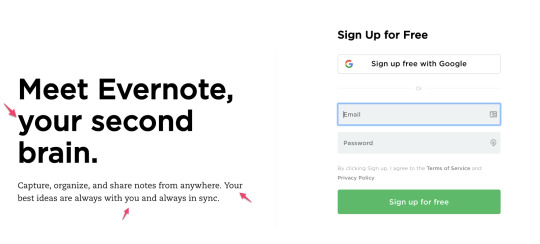
These words highlight to your prospects that the main reason for this landing page (and your business) is to help them solve their problems.
5. Use visual aids
Like we said, your landing page is only one page, so everything should be there for a reason and have a purpose. The same rule applies to any images or videos you use.
When you’re adding images to your landing page, you should utilize ones that help your visitors visualize their life after they’ve taken your action.
Airbnb is a business that focuses on people. So it makes sense that they should use images of people on their landing page:

They want their users to feel accomplished and happy if they sign up as an Airbnb host, so they include an image of a woman smiling.
For anyone thinking about signing up for the Airbnb platform, seeing an image like this will encourage them it’s a good idea.
Shopify, an e-commerce platform, uses images to show visitors how their shop could look:

You can utilize images to guide your audience towards the call to action.
The images make your offer more human.
Your audience cannot touch or hold your product. Your landing page should make use of images to help them visualize it.
6. Include social proof
When creating a mind-reading landing page, understand that one question your audience will have is, “Do I need this?”
This is true for every landing page.
One way to read their minds is to address their question through the concept of social proof.
People are more inclined to take action if they know other people just like them have taken action and benefited from it.
Using social proof on your landing page provides prospects with another layer of trust. They feel like it’s more likely your product/service will actually do what you say it will because they can see what other people thought about it.
For example, check out what Freshdesk does on their landing page:
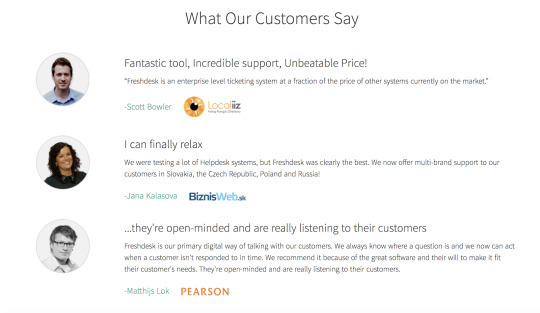
Do you have reviews and testimonials for your product you can use on the landing page?
Visitors get to experience how their life could be different from signing up. And they learn that from other people just like them.
7. Utilize a call to action
Your call to action button is important. It’s perhaps the most important element on the page.
If your audience can’t see your button clearly, they’re not going to know what to do.
Each landing page should have a call to action. The call to action is there to guide your user’s attention.
Let’s talk about your call to action button copy.
Your button copy should be action driven and relate to the offer available.
“Download” copy on the call to action is vague, and the visitor might not even remember what it is they’re downloading.
Take a look at the call to action button on Hired. It stands out as the only red button on the page:
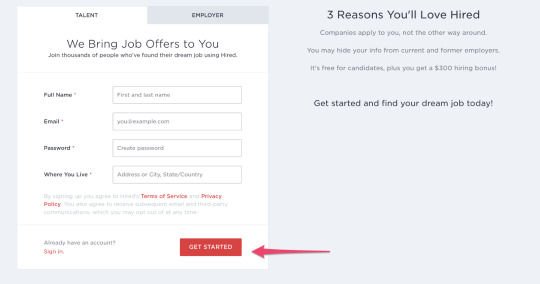
Alexa uses the “Try 7 days free” copy, which takes the pressure off the visitor. They don’t have to fully commit to using the service, and won’t be charged if they’re not happy with it:
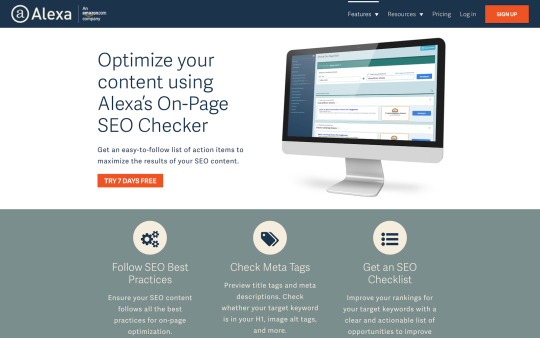
Both Hired and Alexa use excited copy like “Get started.” Using the word “get” psychologically makes people feel as though they are getting something in return for giving you their details.
8. Measure your results
If you don’t measure the results of your landing page, you have no real way of understanding whether or not it is converting successfully.
Use Google Analytics to measure how many visitors came to your landing page and converted by giving you their data.
When looking at the effectiveness of your landing page, consider your bounce rate.
Your bounce rate is the number of people who landed on your landing page and didn’t convert.
If your bounce rate is low it could mean one of the following things:
You aren’t using the right keywords. Your keywords should be relevant to the audience you want to attract. If not, you will have a bunch of untargeted prospects coming to your site with no interest in what you’re offering.
The design on your landing page is poor. Consider how often the average person spends on your landing page. If it doesn’t follow a logical flow or is too confusing, they’re more than likely going to bounce.
9. Make sure you test
The only way to know if your attempts are working is to run tests.
A/B testing your landing page involves splitting your traffic in half, so half the traffic sees one version of the landing page and the other half sees another.
This way you will be able to make informed decisions about what does and doesn’t work.
You can compare two versions of your landing page and test different elements.
Do you have two headlines you want to use, but you aren’t sure which will work best? Use A/B testing.
Then after you’ve generated enough traffic, you’ll be able to see which led to the highest number of conversions.
With this data, you can continually improve your landing page to ensure it converts the most people.
When testing elements, don’t try and test everything all at once. If you do this, you’ll have no clear idea what you need to change and what you need to keep the same.
Instead, change a few elements at a time and keep the other elements the same as a control variable.
Conclusion
Your landing page has one job, and one job only: To convert.
So why are you not doing everything you can to encourage your visitors to take your desired action?
It all begins with planning.
But the planning begins even before you start thinking about what you will have on your landing page.
If you want it to be successful, you have to read your prospects’ minds.
Essentially, you need to know your customers really well.
Once you know them, you’ll determine what words, images, and reasoning resonate most with them.
And once you start using their own ideas on your landing pages, your conversion rates are going to increase.
But, with everything in marketing, there is no one size fits all.
Follow the best practices listed in this post and develop your understanding of your audience, and you’ll be able to create winning landing pages for all your offers.
What strategies do you use to improve your landing pages?
The post 9 Steps to Creating a Landing Page That Reads Your Prospects’ Minds appeared first on Neil Patel.
Original content source: https://ift.tt/2g0VS1J via https://neilpatel.com
The post, 9 Steps to Creating a Landing Page That Reads Your Prospects’ Minds, has been shared from https://ift.tt/3e1bBc5 via https://ift.tt/2r0Go64
0 notes
Text
9 Steps to Creating a Landing Page That Reads Your Prospects’ Minds
So you’ve decided to create a landing page to promote your new product or service.
But how do you know if your landing page will convince your readers to convert?
There are a number of things you can do to ensure your readers are enticed by your landing page and want to know more information.
In this post, we’re going to figure out exactly what you need to do to produce a mind-reading landing page. But first, let’s start with the basics.
What is a landing page?
Before you create a landing page, you need to understand exactly what it is.
A landing page is a dedicated web page, often called a squeeze or splash page. The objective is to collect your visitor’s data through a lead capture form.
You might use a landing page to give away a free e-book, webinar, or course in exchange for your audience signing up for your email list.
Or maybe you collect emails before launching your new website.
The best part about a landing page is that it’s only one page.
It’s one page you need to optimize.
Why, then, do so many people make mistakes with their landing pages?
And why do so many people struggle to convert their customers?
A well-crafted landing page will enable you to target a specific audience, create a compelling message, and increase conversions.
But what goes into creating an effective one?
What makes some landing pages successful and some fall flat on their face?
It all comes down to whether you know your audience or not.
Those who know their audience will be able to create the right messaging, hold their audience’s attention, and come up with a mind-reading landing page.
But just how do you do that?
Let’s find out.
1. Create a persona
It all begins with creating your ideal persona. When you know who you’re targeting, you will be better equipped to create a landing page that resonates with them.
Your personas should be your ideal target audience. After all, if the right people aren’t visiting your landing page, you will never convert in the first place.
Your personas should include demographic information like where they live, their ages, and their genders.
But they should go further than that.
If you want to create a mind-reading landing page, you need to know what inspires your ideal personas and what they hope to achieve.
You must find out their opinions and how they feel towards specific ideas.
When you do this, you’ll able to position your offer to them so that it’s irresistible.
Buffer uses personas to connect with their target customers.
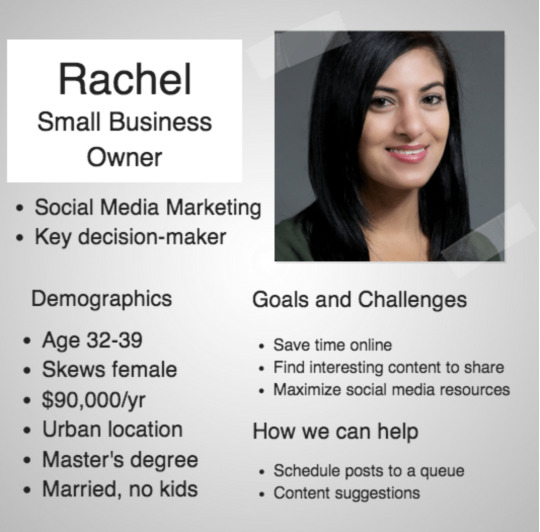
Using the information they’ve put together here, they will have a greater understanding of how to create their landing page.
You want to increase your chance of conversion, so don’t try to make your landing page appeal to absolutely everyone.
Instead, use the data in your personas to produce highly-targeted landing pages that speak to a specific group of people.
You only have a few moments to grab your visitor’s attention. And in those short few moments, they’ll decide whether or not they want to convert.
2. Present the offer
The reason landing pages are so effective is that they isolate the action.
There shouldn’t be a menu or other links on the landing page. It should all guide the visitor toward completing the action you want them to take.
Distracting them with multiple options is a surefire way to confuse them. Your conversion rate will suffer.
Do not give your visitors a choice. Make it clear what you want them to do.
The only option they should have is to convert or not to convert, like in this example from Geico:

The clear landing page means that whoever lands on the page only has one option. Enter their zip code or not.
But just making the chosen action clear isn’t enough to ensure that your visitors convert.
You need to create an offer that resonates with them enough to take the action.
Think about it. A landing page that asks its users to sign up for the newsletter in exchange for nothing isn’t going to convert very well.
Why?
Because there’s no incentive. Why should your visitor do anything for you without getting something in return?
And no, your newsletter alone is not enough of an incentive.
But creating a compelling offer doesn’t have to be a complicated task. You just need to provide your audience something they actually want.
Autopilot knows their readers would be interested in growing revenue with Instapage, so a replay of the webinar would be beneficial to them.
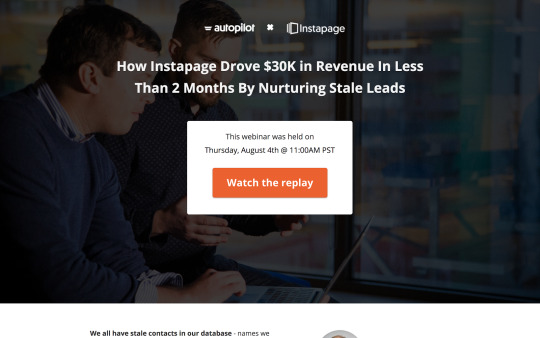
This is a good example of a strong offer.
If you already have a landing page that you’re looking to improve, ask yourself whether or not as a visitor you would take the desired action.
If the answer is no, then there are changes you need to make.
If you’re struggling to create an offer, but you know you want to build your email list with a landing page, then look at your most popular piece of content.
We can see here that the most popular piece of content on my blog is [enter content].
If you were to offer this content as a downloadable PDF or checklist, people would be likely to give you their email address in exchange.
Why?
Because you already know it performs well. You have proof there’s a need for it.
Here, the hard work is done for you. Find a popular piece of content, find a way to repackage it as a downloadable piece, and offer it to your audience.
But what if your landing page isn’t for an e-book, checklist, or downloadable PDF?
Think about other ways you can provide value to your audience.
3. Write the headline
Once you’ve got your offer down, you need to start working on the headline. The headline must be captivating.
It’s usually the first thing your visitor will see, so you need to perfect it.
youtube
The headline is often the deciding factor of whether or not a visitor will convert. And you only have one real opportunity to make it work.
Your headline should be driven by the benefits. You need to outline exactly what will happen to the visitor once they take your desired action.
Capital One makes use of both a heading a subheading to get their point across:
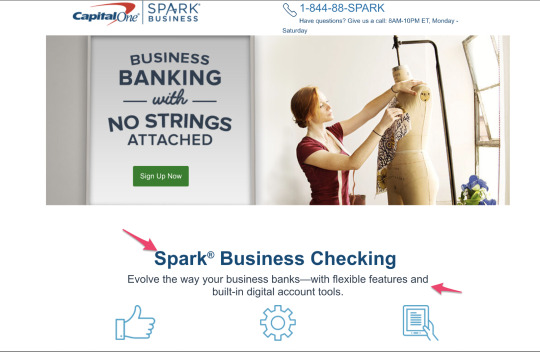
They know people who are interested in their service are going to want to have their business in order, so they position their offer in that sequence.
Salesforce has a clear headline and message:
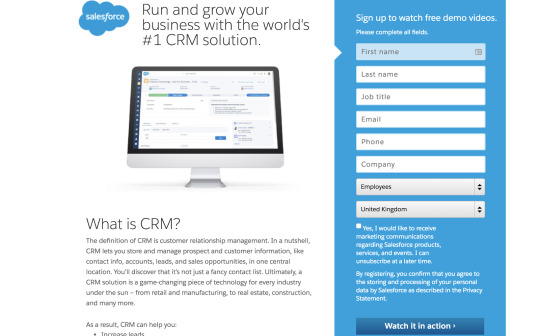
This headline is great because it grabs the audience’s attention. They’re immediately drawn to it. Visitors automatically know what will happen if they fill in the form on the right.
Joanna Wiebe of Copy Hackers says if you’re struggling to find the right words, then look at the language your audience uses.
Why is this effective?
Because if you use your audience’s own language in your headline, it will resonate better with them.
After the headline, you’re likely going to use a subheading.
This is another opportunity to mention the benefits. It’s for people who were compelled by the headline but need some more convincing.
It gives you another chance to keep their attention and draw them closer to your call to action.
4. Create the copy
Good copy sells. You know that. It’s why some companies pay copywriters thousands to put words on a page.
But it’s not as easy as just writing words on a page. They have to mean something to your target customer.
As we mentioned with the headline, if you’re struggling to find words, then utilize the language your prospects use.
Your copy is there as a tool to help you get your point and message across and increase the chance of conversion.
It all begins with finding the sweet spot for the right amount of copy. Write too little and you won’t have enough words to get your point across. But write too much and the page will become overwhelming.
However, just saying “find the sweet spot” doesn’t help you.
In general terms, the amount you write depends on the offer. For things that need a lot of explaining and persuading, you’re going to need more copy.
For things that require the prospect to provide you with more than just their email address, i.e. when they are making a purchase, you are naturally going to need to use additional copy to ensure all the necessary details are there.
When it comes to actually writing your copy, you should mirror your brand’s style.
Keep in mind that it’s not about you. It’s about the customer, so the phrasing you use should be customer-centric and focus on them.
Evernote personalizes their landing page copy by avoiding using words like “we” or “our” and instead opts for words like “your” and “you”:

These words highlight to your prospects that the main reason for this landing page (and your business) is to help them solve their problems.
5. Use visual aids
Like we said, your landing page is only one page, so everything should be there for a reason and have a purpose. The same rule applies to any images or videos you use.
When you’re adding images to your landing page, you should utilize ones that help your visitors visualize their life after they’ve taken your action.
Airbnb is a business that focuses on people. So it makes sense that they should use images of people on their landing page:
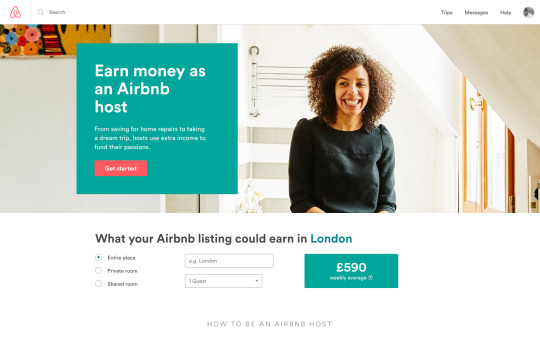
They want their users to feel accomplished and happy if they sign up as an Airbnb host, so they include an image of a woman smiling.
For anyone thinking about signing up for the Airbnb platform, seeing an image like this will encourage them it’s a good idea.
Shopify, an e-commerce platform, uses images to show visitors how their shop could look:
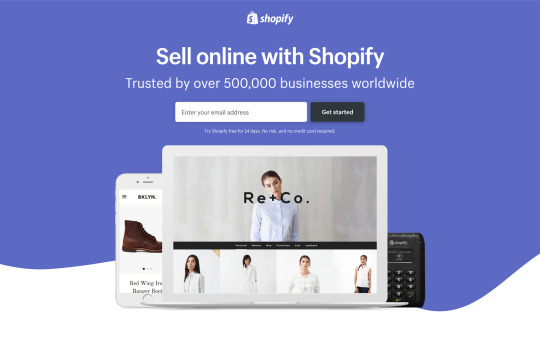
You can utilize images to guide your audience towards the call to action.
The images make your offer more human.
Your audience cannot touch or hold your product. Your landing page should make use of images to help them visualize it.
6. Include social proof
When creating a mind-reading landing page, understand that one question your audience will have is, “Do I need this?”
This is true for every landing page.
One way to read their minds is to address their question through the concept of social proof.
People are more inclined to take action if they know other people just like them have taken action and benefited from it.
Using social proof on your landing page provides prospects with another layer of trust. They feel like it’s more likely your product/service will actually do what you say it will because they can see what other people thought about it.
For example, check out what Freshdesk does on their landing page:
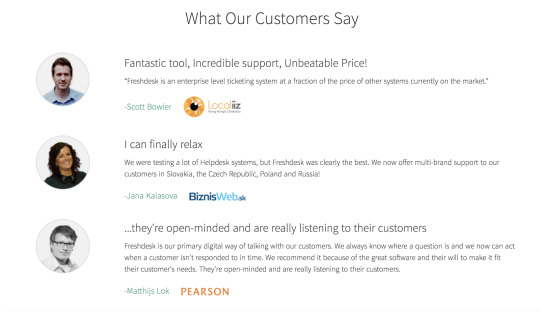
Do you have reviews and testimonials for your product you can use on the landing page?
Visitors get to experience how their life could be different from signing up. And they learn that from other people just like them.
7. Utilize a call to action
Your call to action button is important. It’s perhaps the most important element on the page.
If your audience can’t see your button clearly, they’re not going to know what to do.
Each landing page should have a call to action. The call to action is there to guide your user’s attention.
Let’s talk about your call to action button copy.
Your button copy should be action driven and relate to the offer available.
“Download” copy on the call to action is vague, and the visitor might not even remember what it is they’re downloading.
Take a look at the call to action button on Hired. It stands out as the only red button on the page:
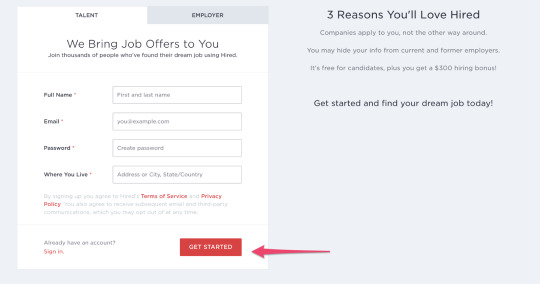
Alexa uses the “Try 7 days free” copy, which takes the pressure off the visitor. They don’t have to fully commit to using the service, and won’t be charged if they’re not happy with it:
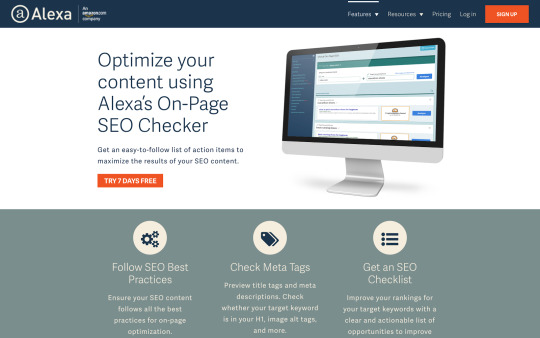
Both Hired and Alexa use excited copy like “Get started.” Using the word “get” psychologically makes people feel as though they are getting something in return for giving you their details.
8. Measure your results
If you don’t measure the results of your landing page, you have no real way of understanding whether or not it is converting successfully.
Use Google Analytics to measure how many visitors came to your landing page and converted by giving you their data.
When looking at the effectiveness of your landing page, consider your bounce rate.
Your bounce rate is the number of people who landed on your landing page and didn’t convert.
If your bounce rate is low it could mean one of the following things:
You aren’t using the right keywords. Your keywords should be relevant to the audience you want to attract. If not, you will have a bunch of untargeted prospects coming to your site with no interest in what you’re offering.
The design on your landing page is poor. Consider how often the average person spends on your landing page. If it doesn’t follow a logical flow or is too confusing, they’re more than likely going to bounce.
9. Make sure you test
The only way to know if your attempts are working is to run tests.
A/B testing your landing page involves splitting your traffic in half, so half the traffic sees one version of the landing page and the other half sees another.
This way you will be able to make informed decisions about what does and doesn’t work.
You can compare two versions of your landing page and test different elements.
Do you have two headlines you want to use, but you aren’t sure which will work best? Use A/B testing.
Then after you’ve generated enough traffic, you’ll be able to see which led to the highest number of conversions.
With this data, you can continually improve your landing page to ensure it converts the most people.
When testing elements, don’t try and test everything all at once. If you do this, you’ll have no clear idea what you need to change and what you need to keep the same.
Instead, change a few elements at a time and keep the other elements the same as a control variable.
Conclusion
Your landing page has one job, and one job only: To convert.
So why are you not doing everything you can to encourage your visitors to take your desired action?
It all begins with planning.
But the planning begins even before you start thinking about what you will have on your landing page.
If you want it to be successful, you have to read your prospects’ minds.
Essentially, you need to know your customers really well.
Once you know them, you’ll determine what words, images, and reasoning resonate most with them.
And once you start using their own ideas on your landing pages, your conversion rates are going to increase.
But, with everything in marketing, there is no one size fits all.
Follow the best practices listed in this post and develop your understanding of your audience, and you’ll be able to create winning landing pages for all your offers.
What strategies do you use to improve your landing pages?
The post 9 Steps to Creating a Landing Page That Reads Your Prospects’ Minds appeared first on Neil Patel.
9 Steps to Creating a Landing Page That Reads Your Prospects’ Minds Publicado primeiro em https://neilpatel.com
0 notes
Text
9 Steps to Creating a Landing Page That Reads Your Prospects Minds
So you’ve decided to create a landing page to promote your new product or service.
But how do you know if your landing page will convince your readers to convert?
There are a number of things you can do to ensure your readers are enticed by your landing page and want to know more information.
In this post, we’re going to figure out exactly what you need to do to produce a mind-reading landing page. But first, let’s start with the basics.
What is a landing page?
Before you create a landing page, you need to understand exactly what it is.
A landing page is a dedicated web page, often called a squeeze or splash page. The objective is to collect your visitor’s data through a lead capture form.
You might use a landing page to give away a free e-book, webinar, or course in exchange for your audience signing up for your email list.
Or maybe you collect emails before launching your new website.
The best part about a landing page is that it’s only one page.
It’s one page you need to optimize.
Why, then, do so many people make mistakes with their landing pages?
And why do so many people struggle to convert their customers?
A well-crafted landing page will enable you to target a specific audience, create a compelling message, and increase conversions.
But what goes into creating an effective one?
What makes some landing pages successful and some fall flat on their face?
It all comes down to whether you know your audience or not.
Those who know their audience will be able to create the right messaging, hold their audience’s attention, and come up with a mind-reading landing page.
But just how do you do that?
Let’s find out.
1. Create a persona
It all begins with creating your ideal persona. When you know who you’re targeting, you will be better equipped to create a landing page that resonates with them.
Your personas should be your ideal target audience. After all, if the right people aren’t visiting your landing page, you will never convert in the first place.
Your personas should include demographic information like where they live, their ages, and their genders.
But they should go further than that.
If you want to create a mind-reading landing page, you need to know what inspires your ideal personas and what they hope to achieve.
You must find out their opinions and how they feel towards specific ideas.
When you do this, you’ll able to position your offer to them so that it’s irresistible.
Buffer uses personas to connect with their target customers.
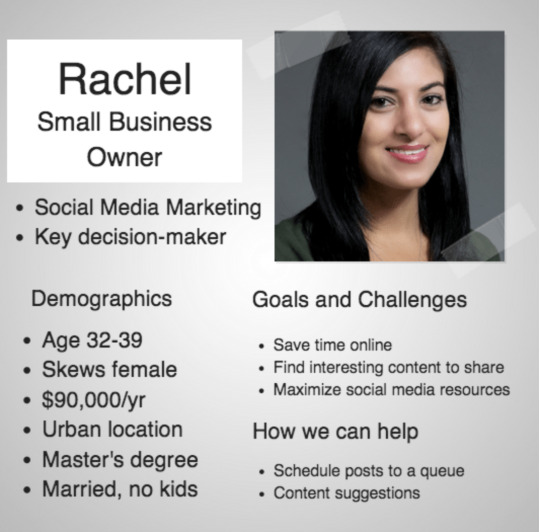
Using the information they’ve put together here, they will have a greater understanding of how to create their landing page.
You want to increase your chance of conversion, so don’t try to make your landing page appeal to absolutely everyone.
Instead, use the data in your personas to produce highly-targeted landing pages that speak to a specific group of people.
You only have a few moments to grab your visitor’s attention. And in those short few moments, they’ll decide whether or not they want to convert.
2. Present the offer
The reason landing pages are so effective is that they isolate the action.
There shouldn’t be a menu or other links on the landing page. It should all guide the visitor toward completing the action you want them to take.
Distracting them with multiple options is a surefire way to confuse them. Your conversion rate will suffer.
Do not give your visitors a choice. Make it clear what you want them to do.
The only option they should have is to convert or not to convert, like in this example from Geico:
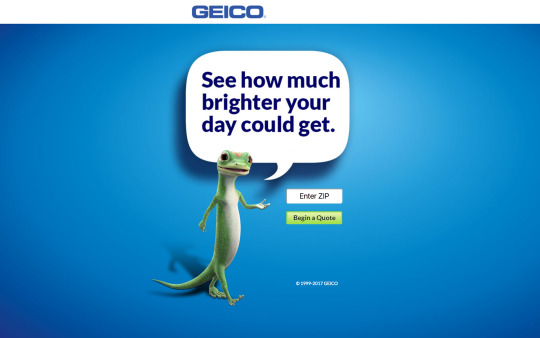
The clear landing page means that whoever lands on the page only has one option. Enter their zip code or not.
But just making the chosen action clear isn’t enough to ensure that your visitors convert.
You need to create an offer that resonates with them enough to take the action.
Think about it. A landing page that asks its users to sign up for the newsletter in exchange for nothing isn’t going to convert very well.
Why?
Because there’s no incentive. Why should your visitor do anything for you without getting something in return?
And no, your newsletter alone is not enough of an incentive.
But creating a compelling offer doesn’t have to be a complicated task. You just need to provide your audience something they actually want.
Autopilot knows their readers would be interested in growing revenue with Instapage, so a replay of the webinar would be beneficial to them.
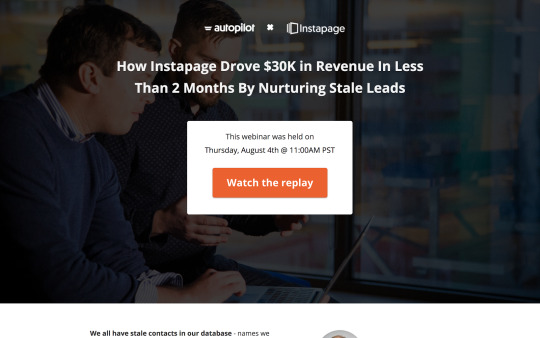
This is a good example of a strong offer.
If you already have a landing page that you’re looking to improve, ask yourself whether or not as a visitor you would take the desired action.
If the answer is no, then there are changes you need to make.
If you’re struggling to create an offer, but you know you want to build your email list with a landing page, then look at your most popular piece of content.
We can see here that the most popular piece of content on my blog is [enter content].
If you were to offer this content as a downloadable PDF or checklist, people would be likely to give you their email address in exchange.
Why?
Because you already know it performs well. You have proof there’s a need for it.
Here, the hard work is done for you. Find a popular piece of content, find a way to repackage it as a downloadable piece, and offer it to your audience.
But what if your landing page isn’t for an e-book, checklist, or downloadable PDF?
Think about other ways you can provide value to your audience.
3. Write the headline
Once you’ve got your offer down, you need to start working on the headline. The headline must be captivating.
It’s usually the first thing your visitor will see, so you need to perfect it.
The headline is often the deciding factor of whether or not a visitor will convert. And you only have one real opportunity to make it work.
Your headline should be driven by the benefits. You need to outline exactly what will happen to the visitor once they take your desired action.
Capital One makes use of both a heading a subheading to get their point across:
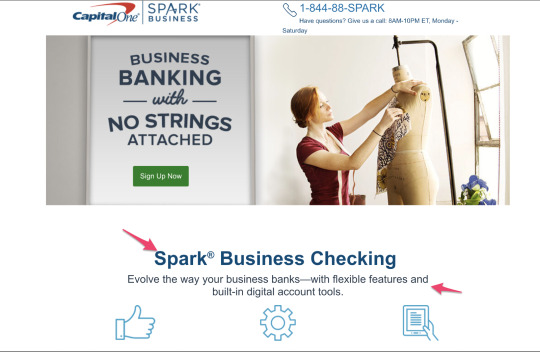
They know people who are interested in their service are going to want to have their business in order, so they position their offer in that sequence.
Salesforce has a clear headline and message:
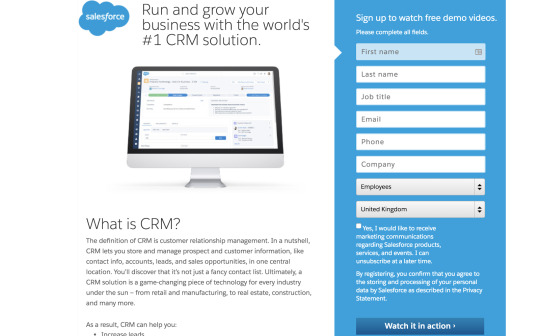
This headline is great because it grabs the audience’s attention. They’re immediately drawn to it. Visitors automatically know what will happen if they fill in the form on the right.
Joanna Wiebe of Copy Hackers says if you’re struggling to find the right words, then look at the language your audience uses.
Why is this effective?
Because if you use your audience’s own language in your headline, it will resonate better with them.
After the headline, you’re likely going to use a subheading.
This is another opportunity to mention the benefits. It’s for people who were compelled by the headline but need some more convincing.
It gives you another chance to keep their attention and draw them closer to your call to action.
4. Create the copy
Good copy sells. You know that. It’s why some companies pay copywriters thousands to put words on a page.
But it’s not as easy as just writing words on a page. They have to mean something to your target customer.
As we mentioned with the headline, if you’re struggling to find words, then utilize the language your prospects use.
Your copy is there as a tool to help you get your point and message across and increase the chance of conversion.
It all begins with finding the sweet spot for the right amount of copy. Write too little and you won’t have enough words to get your point across. But write too much and the page will become overwhelming.
However, just saying “find the sweet spot” doesn’t help you.
In general terms, the amount you write depends on the offer. For things that need a lot of explaining and persuading, you’re going to need more copy.
For things that require the prospect to provide you with more than just their email address, i.e. when they are making a purchase, you are naturally going to need to use additional copy to ensure all the necessary details are there.
When it comes to actually writing your copy, you should mirror your brand’s style.
Keep in mind that it’s not about you. It’s about the customer, so the phrasing you use should be customer-centric and focus on them.
Evernote personalizes their landing page copy by avoiding using words like “we” or “our” and instead opts for words like “your” and “you”:
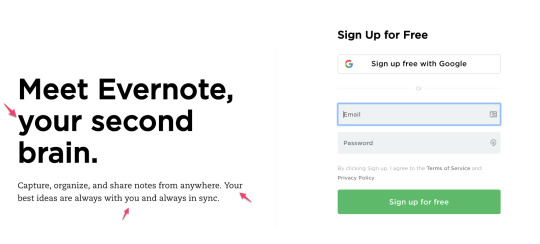
These words highlight to your prospects that the main reason for this landing page (and your business) is to help them solve their problems.
5. Use visual aids
Like we said, your landing page is only one page, so everything should be there for a reason and have a purpose. The same rule applies to any images or videos you use.
When you’re adding images to your landing page, you should utilize ones that help your visitors visualize their life after they’ve taken your action.
Airbnb is a business that focuses on people. So it makes sense that they should use images of people on their landing page:

They want their users to feel accomplished and happy if they sign up as an Airbnb host, so they include an image of a woman smiling.
For anyone thinking about signing up for the Airbnb platform, seeing an image like this will encourage them it’s a good idea.
Shopify, an e-commerce platform, uses images to show visitors how their shop could look:
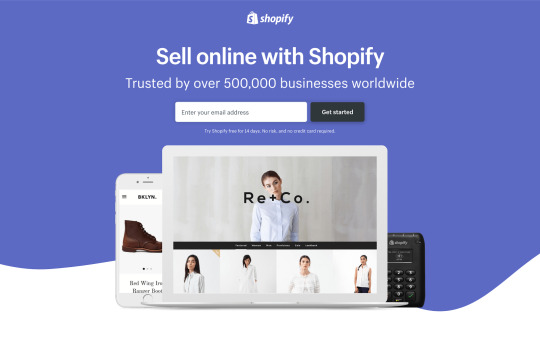
You can utilize images to guide your audience towards the call to action.
The images make your offer more human.
Your audience cannot touch or hold your product. Your landing page should make use of images to help them visualize it.
6. Include social proof
When creating a mind-reading landing page, understand that one question your audience will have is, “Do I need this?”
This is true for every landing page.
One way to read their minds is to address their question through the concept of social proof.
People are more inclined to take action if they know other people just like them have taken action and benefited from it.
Using social proof on your landing page provides prospects with another layer of trust. They feel like it’s more likely your product/service will actually do what you say it will because they can see what other people thought about it.
For example, check out what Freshdesk does on their landing page:
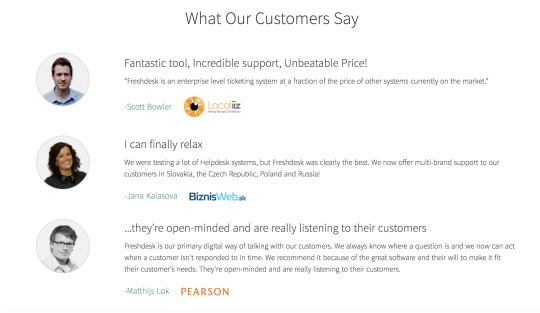
Do you have reviews and testimonials for your product you can use on the landing page?
Visitors get to experience how their life could be different from signing up. And they learn that from other people just like them.
7. Utilize a call to action
Your call to action button is important. It’s perhaps the most important element on the page.
If your audience can’t see your button clearly, they’re not going to know what to do.
Each landing page should have a call to action. The call to action is there to guide your user’s attention.
Let’s talk about your call to action button copy.
Your button copy should be action driven and relate to the offer available.
“Download” copy on the call to action is vague, and the visitor might not even remember what it is they’re downloading.
Take a look at the call to action button on Hired. It stands out as the only red button on the page:
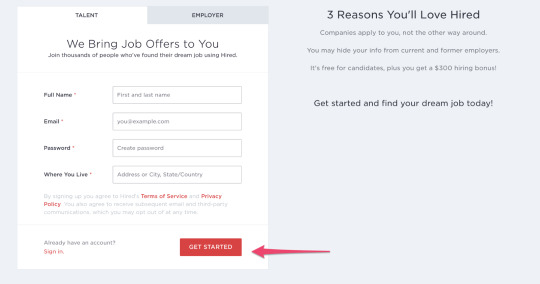
Alexa uses the “Try 7 days free” copy, which takes the pressure off the visitor. They don’t have to fully commit to using the service, and won’t be charged if they’re not happy with it:

Both Hired and Alexa use excited copy like “Get started.” Using the word “get” psychologically makes people feel as though they are getting something in return for giving you their details.
8. Measure your results
If you don’t measure the results of your landing page, you have no real way of understanding whether or not it is converting successfully.
Use Google Analytics to measure how many visitors came to your landing page and converted by giving you their data.
When looking at the effectiveness of your landing page, consider your bounce rate.
Your bounce rate is the number of people who landed on your landing page and didn’t convert.
If your bounce rate is low it could mean one of the following things:
You aren’t using the right keywords. Your keywords should be relevant to the audience you want to attract. If not, you will have a bunch of untargeted prospects coming to your site with no interest in what you’re offering.
The design on your landing page is poor. Consider how often the average person spends on your landing page. If it doesn’t follow a logical flow or is too confusing, they’re more than likely going to bounce.
9. Make sure you test
The only way to know if your attempts are working is to run tests.
A/B testing your landing page involves splitting your traffic in half, so half the traffic sees one version of the landing page and the other half sees another.
This way you will be able to make informed decisions about what does and doesn’t work.
You can compare two versions of your landing page and test different elements.
Do you have two headlines you want to use, but you aren’t sure which will work best? Use A/B testing.
Then after you’ve generated enough traffic, you’ll be able to see which led to the highest number of conversions.
With this data, you can continually improve your landing page to ensure it converts the most people.
When testing elements, don’t try and test everything all at once. If you do this, you’ll have no clear idea what you need to change and what you need to keep the same.
Instead, change a few elements at a time and keep the other elements the same as a control variable.
Conclusion
Your landing page has one job, and one job only: To convert.
So why are you not doing everything you can to encourage your visitors to take your desired action?
It all begins with planning.
But the planning begins even before you start thinking about what you will have on your landing page.
If you want it to be successful, you have to read your prospects’ minds.
Essentially, you need to know your customers really well.
Once you know them, you’ll determine what words, images, and reasoning resonate most with them.
And once you start using their own ideas on your landing pages, your conversion rates are going to increase.
But, with everything in marketing, there is no one size fits all.
Follow the best practices listed in this post and develop your understanding of your audience, and you’ll be able to create winning landing pages for all your offers.
What strategies do you use to improve your landing pages?
The post 9 Steps to Creating a Landing Page That Reads Your Prospects’ Minds appeared first on Neil Patel.
Original content source: https://neilpatel.com/blog/mind-reading-landing-page/ via https://neilpatel.com
See the original post, 9 Steps to Creating a Landing Page That Reads Your Prospects Minds that is shared from https://imtrainingparadise.weebly.com/home/9-steps-to-creating-a-landing-page-that-reads-your-prospects-minds via https://imtrainingparadise.weebly.com/home
0 notes
Text
9 Steps to Creating a Landing Page That Reads Your Prospects’ Minds
email marketing developer cover letter
So you’ve decided to create a landing page to promote your new product or service.
But how do you know if your landing page will convince your readers to convert?
There are a number of things you can do to ensure your readers are enticed by your landing page and want to know more information.
In this post, we’re going to figure out exactly what you need to do to produce a mind-reading landing page. But first, let’s start with the basics.
What is a landing page?
Before you create a landing page, you need to understand exactly what it is.
A landing page is a dedicated web page, often called a squeeze or splash page. The objective is to collect your visitor’s data through a lead capture form.
You might use a landing page to give away a free e-book, webinar, or course in exchange for your audience signing up for your email list.
Or maybe you collect emails before launching your new website.
The best part about a landing page is that it’s only one page.
It’s one page you need to optimize.
Why, then, do so many people make mistakes with their landing pages?
And why do so many people struggle to convert their customers?
A well-crafted landing page will enable you to target a specific audience, create a compelling message, and increase conversions.
But what goes into creating an effective one?
What makes some landing pages successful and some fall flat on their face?
It all comes down to whether you know your audience or not.
Those who know their audience will be able to create the right messaging, hold their audience’s attention, and come up with a mind-reading landing page.
But just how do you do that?
Let’s find out.
1. Create a persona
It all begins with creating your ideal persona. When you know who you’re targeting, you will be better equipped to create a landing page that resonates with them.
Your personas should be your ideal target audience. After all, if the right people aren’t visiting your landing page, you will never convert in the first place.
Your personas should include demographic information like where they live, their ages, and their genders.
But they should go further than that.
If you want to create a mind-reading landing page, you need to know what inspires your ideal personas and what they hope to achieve.
You must find out their opinions and how they feel towards specific ideas.
When you do this, you’ll able to position your offer to them so that it’s irresistible.
Buffer uses personas to connect with their target customers.
Using the information they’ve put together here, they will have a greater understanding of how to create their landing page.
You want to increase your chance of conversion, so don’t try to make your landing page appeal to absolutely everyone.
Instead, use the data in your personas to produce highly-targeted landing pages that speak to a specific group of people.
You only have a few moments to grab your visitor’s attention. And in those short few moments, they’ll decide whether or not they want to convert.
2. Present the offer
The reason landing pages are so effective is that they isolate the action.
There shouldn’t be a menu or other links on the landing page. It should all guide the visitor toward completing the action you want them to take.
Distracting them with multiple options is a surefire way to confuse them. Your conversion rate will suffer.
Do not give your visitors a choice. Make it clear what you want them to do.
The only option they should have is to convert or not to convert, like in this example from Geico:
The clear landing page means that whoever lands on the page only has one option. Enter their zip code or not.
But just making the chosen action clear isn’t enough to ensure that your visitors convert.
You need to create an offer that resonates with them enough to take the action.
Think about it. A landing page that asks its users to sign up for the newsletter in exchange for nothing isn’t going to convert very well.
Why?
Because there’s no incentive. Why should your visitor do anything for you without getting something in return?
And no, your newsletter alone is not enough of an incentive.
But creating a compelling offer doesn’t have to be a complicated task. You just need to provide your audience something they actually want.
Autopilot knows their readers would be interested in growing revenue with Instapage, so a replay of the webinar would be beneficial to them.
This is a good example of a strong offer.
If you already have a landing page that you’re looking to improve, ask yourself whether or not as a visitor you would take the desired action.
If the answer is no, then there are changes you need to make.
If you’re struggling to create an offer, but you know you want to build your email list with a landing page, then look at your most popular piece of content.
We can see here that the most popular piece of content on my blog is [enter content].
If you were to offer this content as a downloadable PDF or checklist, people would be likely to give you their email address in exchange.
Why?
Because you already know it performs well. You have proof there’s a need for it.
Here, the hard work is done for you. Find a popular piece of content, find a way to repackage it as a downloadable piece, and offer it to your audience.
But what if your landing page isn’t for an e-book, checklist, or downloadable PDF?
Think about other ways you can provide value to your audience.
3. Write the headline
Once you’ve got your offer down, you need to start working on the headline. The headline must be captivating.
It’s usually the first thing your visitor will see, so you need to perfect it.
youtube
The headline is often the deciding factor of whether or not a visitor will convert. And you only have one real opportunity to make it work.
Your headline should be driven by the benefits. You need to outline exactly what will happen to the visitor once they take your desired action.
Capital One makes use of both a heading a subheading to get their point across:
They know people who are interested in their service are going to want to have their business in order, so they position their offer in that sequence.
Salesforce has a clear headline and message:
This headline is great because it grabs the audience’s attention. They’re immediately drawn to it. Visitors automatically know what will happen if they fill in the form on the right.
Joanna Wiebe of Copy Hackers says if you’re struggling to find the right words, then look at the language your audience uses.
Why is this effective?
Because if you use your audience’s own language in your headline, it will resonate better with them.
After the headline, you’re likely going to use a subheading.
This is another opportunity to mention the benefits. It’s for people who were compelled by the headline but need some more convincing.
It gives you another chance to keep their attention and draw them closer to your call to action.
4. Create the copy
Good copy sells. You know that. It’s why some companies pay copywriters thousands to put words on a page.
But it’s not as easy as just writing words on a page. They have to mean something to your target customer.
As we mentioned with the headline, if you’re struggling to find words, then utilize the language your prospects use.
Your copy is there as a tool to help you get your point and message across and increase the chance of conversion.
It all begins with finding the sweet spot for the right amount of copy. Write too little and you won’t have enough words to get your point across. But write too much and the page will become overwhelming.
However, just saying “find the sweet spot” doesn’t help you.
In general terms, the amount you write depends on the offer. For things that need a lot of explaining and persuading, you’re going to need more copy.
For things that require the prospect to provide you with more than just their email address, i.e. when they are making a purchase, you are naturally going to need to use additional copy to ensure all the necessary details are there.
When it comes to actually writing your copy, you should mirror your brand’s style.
Keep in mind that it’s not about you. It’s about the customer, so the phrasing you use should be customer-centric and focus on them.
Evernote personalizes their landing page copy by avoiding using words like “we” or “our” and instead opts for words like “your” and “you”:
These words highlight to your prospects that the main reason for this landing page (and your business) is to help them solve their problems.
5. Use visual aids
Like we said, your landing page is only one page, so everything should be there for a reason and have a purpose. The same rule applies to any images or videos you use.
When you’re adding images to your landing page, you should utilize ones that help your visitors visualize their life after they’ve taken your action.
Airbnb is a business that focuses on people. So it makes sense that they should use images of people on their landing page:
They want their users to feel accomplished and happy if they sign up as an Airbnb host, so they include an image of a woman smiling.
For anyone thinking about signing up for the Airbnb platform, seeing an image like this will encourage them it’s a good idea.
Shopify, an e-commerce platform, uses images to show visitors how their shop could look:
You can utilize images to guide your audience towards the call to action.
The images make your offer more human.
Your audience cannot touch or hold your product. Your landing page should make use of images to help them visualize it.
6. Include social proof
When creating a mind-reading landing page, understand that one question your audience will have is, “Do I need this?”
This is true for every landing page.
One way to read their minds is to address their question through the concept of social proof.
People are more inclined to take action if they know other people just like them have taken action and benefited from it.
Using social proof on your landing page provides prospects with another layer of trust. They feel like it’s more likely your product/service will actually do what you say it will because they can see what other people thought about it.
For example, check out what Freshdesk does on their landing page:
Do you have reviews and testimonials for your product you can use on the landing page?
Visitors get to experience how their life could be different from signing up. And they learn that from other people just like them.
7. Utilize a call to action
Your call to action button is important. It’s perhaps the most important element on the page.
If your audience can’t see your button clearly, they’re not going to know what to do.
Each landing page should have a call to action. The call to action is there to guide your user’s attention.
Let’s talk about your call to action button copy.
Your button copy should be action driven and relate to the offer available.
“Download” copy on the call to action is vague, and the visitor might not even remember what it is they’re downloading.
Take a look at the call to action button on Hired. It stands out as the only red button on the page:
Alexa uses the “Try 7 days free” copy, which takes the pressure off the visitor. They don’t have to fully commit to using the service, and won’t be charged if they’re not happy with it:
Both Hired and Alexa use excited copy like “Get started.” Using the word “get” psychologically makes people feel as though they are getting something in return for giving you their details.
8. Measure your results
If you don’t measure the results of your landing page, you have no real way of understanding whether or not it is converting successfully.
Use Google Analytics to measure how many visitors came to your landing page and converted by giving you their data.
When looking at the effectiveness of your landing page, consider your bounce rate.
Your bounce rate is the number of people who landed on your landing page and didn’t convert.
If your bounce rate is low it could mean one of the following things:
You aren’t using the right keywords. Your keywords should be relevant to the audience you want to attract. If not, you will have a bunch of untargeted prospects coming to your site with no interest in what you’re offering.
The design on your landing page is poor. Consider how often the average person spends on your landing page. If it doesn’t follow a logical flow or is too confusing, they’re more than likely going to bounce.
9. Make sure you test
The only way to know if your attempts are working is to run tests.
A/B testing your landing page involves splitting your traffic in half, so half the traffic sees one version of the landing page and the other half sees another.
This way you will be able to make informed decisions about what does and doesn’t work.
You can compare two versions of your landing page and test different elements.
Do you have two headlines you want to use, but you aren’t sure which will work best? Use A/B testing.
Then after you’ve generated enough traffic, you’ll be able to see which led to the highest number of conversions.
With this data, you can continually improve your landing page to ensure it converts the most people.
When testing elements, don’t try and test everything all at once. If you do this, you’ll have no clear idea what you need to change and what you need to keep the same.
Instead, change a few elements at a time and keep the other elements the same as a control variable.
Conclusion
Your landing page has one job, and one job only: To convert.
So why are you not doing everything you can to encourage your visitors to take your desired action?
It all begins with planning.
But the planning begins even before you start thinking about what you will have on your landing page.
If you want it to be successful, you have to read your prospects’ minds.
Essentially, you need to know your customers really well.
Once you know them, you’ll determine what words, images, and reasoning resonate most with them.
And once you start using their own ideas on your landing pages, your conversion rates are going to increase.
But, with everything in marketing, there is no one size fits all.
Follow the best practices listed in this post and develop your understanding of your audience, and you’ll be able to create winning landing pages for all your offers.
What strategies do you use to improve your landing pages?
FaceBook
0 notes
Text
9 Steps to Creating a Landing Page That Reads Your Prospects’ Minds
So you’ve decided to create a landing page to promote your new product or service.
But how do you know if your landing page will convince your readers to convert?
There are a number of things you can do to ensure your readers are enticed by your landing page and want to know more information.
In this post, we’re going to figure out exactly what you need to do to produce a mind-reading landing page. But first, let’s start with the basics.
What is a landing page?
Before you create a landing page, you need to understand exactly what it is.
A landing page is a dedicated web page, often called a squeeze or splash page. The objective is to collect your visitor’s data through a lead capture form.
You might use a landing page to give away a free e-book, webinar, or course in exchange for your audience signing up for your email list.
Or maybe you collect emails before launching your new website.
The best part about a landing page is that it’s only one page.
It’s one page you need to optimize.
Why, then, do so many people make mistakes with their landing pages?
And why do so many people struggle to convert their customers?
A well-crafted landing page will enable you to target a specific audience, create a compelling message, and increase conversions.
But what goes into creating an effective one?
What makes some landing pages successful and some fall flat on their face?
It all comes down to whether you know your audience or not.
Those who know their audience will be able to create the right messaging, hold their audience’s attention, and come up with a mind-reading landing page.
But just how do you do that?
Let’s find out.
1. Create a persona
It all begins with creating your ideal persona. When you know who you’re targeting, you will be better equipped to create a landing page that resonates with them.
Your personas should be your ideal target audience. After all, if the right people aren’t visiting your landing page, you will never convert in the first place.
Your personas should include demographic information like where they live, their ages, and their genders.
But they should go further than that.
If you want to create a mind-reading landing page, you need to know what inspires your ideal personas and what they hope to achieve.
You must find out their opinions and how they feel towards specific ideas.
When you do this, you’ll able to position your offer to them so that it’s irresistible.
Buffer uses personas to connect with their target customers.
Using the information they’ve put together here, they will have a greater understanding of how to create their landing page.
You want to increase your chance of conversion, so don’t try to make your landing page appeal to absolutely everyone.
Instead, use the data in your personas to produce highly-targeted landing pages that speak to a specific group of people.
You only have a few moments to grab your visitor’s attention. And in those short few moments, they’ll decide whether or not they want to convert.
2. Present the offer
The reason landing pages are so effective is that they isolate the action.
There shouldn’t be a menu or other links on the landing page. It should all guide the visitor toward completing the action you want them to take.
Distracting them with multiple options is a surefire way to confuse them. Your conversion rate will suffer.
Do not give your visitors a choice. Make it clear what you want them to do.
The only option they should have is to convert or not to convert, like in this example from Geico:
The clear landing page means that whoever lands on the page only has one option. Enter their zip code or not.
But just making the chosen action clear isn’t enough to ensure that your visitors convert.
You need to create an offer that resonates with them enough to take the action.
Think about it. A landing page that asks its users to sign up for the newsletter in exchange for nothing isn’t going to convert very well.
Why?
Because there’s no incentive. Why should your visitor do anything for you without getting something in return?
And no, your newsletter alone is not enough of an incentive.
But creating a compelling offer doesn’t have to be a complicated task. You just need to provide your audience something they actually want.
Autopilot knows their readers would be interested in growing revenue with Instapage, so a replay of the webinar would be beneficial to them.
This is a good example of a strong offer.
If you already have a landing page that you’re looking to improve, ask yourself whether or not as a visitor you would take the desired action.
If the answer is no, then there are changes you need to make.
If you’re struggling to create an offer, but you know you want to build your email list with a landing page, then look at your most popular piece of content.
We can see here that the most popular piece of content on my blog is [enter content].
If you were to offer this content as a downloadable PDF or checklist, people would be likely to give you their email address in exchange.
Why?
Because you already know it performs well. You have proof there’s a need for it.
Here, the hard work is done for you. Find a popular piece of content, find a way to repackage it as a downloadable piece, and offer it to your audience.
But what if your landing page isn’t for an e-book, checklist, or downloadable PDF?
Think about other ways you can provide value to your audience.
3. Write the headline
Once you’ve got your offer down, you need to start working on the headline. The headline must be captivating.
It’s usually the first thing your visitor will see, so you need to perfect it.
youtube
The headline is often the deciding factor of whether or not a visitor will convert. And you only have one real opportunity to make it work.
Your headline should be driven by the benefits. You need to outline exactly what will happen to the visitor once they take your desired action.
Capital One makes use of both a heading a subheading to get their point across:
They know people who are interested in their service are going to want to have their business in order, so they position their offer in that sequence.
Salesforce has a clear headline and message:
This headline is great because it grabs the audience’s attention. They’re immediately drawn to it. Visitors automatically know what will happen if they fill in the form on the right.
Joanna Wiebe of Copy Hackers says if you’re struggling to find the right words, then look at the language your audience uses.
Why is this effective?
Because if you use your audience’s own language in your headline, it will resonate better with them.
After the headline, you’re likely going to use a subheading.
This is another opportunity to mention the benefits. It’s for people who were compelled by the headline but need some more convincing.
It gives you another chance to keep their attention and draw them closer to your call to action.
4. Create the copy
Good copy sells. You know that. It’s why some companies pay copywriters thousands to put words on a page.
But it’s not as easy as just writing words on a page. They have to mean something to your target customer.
As we mentioned with the headline, if you’re struggling to find words, then utilize the language your prospects use.
Your copy is there as a tool to help you get your point and message across and increase the chance of conversion.
It all begins with finding the sweet spot for the right amount of copy. Write too little and you won’t have enough words to get your point across. But write too much and the page will become overwhelming.
However, just saying “find the sweet spot” doesn’t help you.
In general terms, the amount you write depends on the offer. For things that need a lot of explaining and persuading, you’re going to need more copy.
For things that require the prospect to provide you with more than just their email address, i.e. when they are making a purchase, you are naturally going to need to use additional copy to ensure all the necessary details are there.
When it comes to actually writing your copy, you should mirror your brand’s style.
Keep in mind that it’s not about you. It’s about the customer, so the phrasing you use should be customer-centric and focus on them.
Evernote personalizes their landing page copy by avoiding using words like “we” or “our” and instead opts for words like “your” and “you”:
These words highlight to your prospects that the main reason for this landing page (and your business) is to help them solve their problems.
5. Use visual aids
Like we said, your landing page is only one page, so everything should be there for a reason and have a purpose. The same rule applies to any images or videos you use.
When you’re adding images to your landing page, you should utilize ones that help your visitors visualize their life after they’ve taken your action.
Airbnb is a business that focuses on people. So it makes sense that they should use images of people on their landing page:
They want their users to feel accomplished and happy if they sign up as an Airbnb host, so they include an image of a woman smiling.
For anyone thinking about signing up for the Airbnb platform, seeing an image like this will encourage them it’s a good idea.
Shopify, an e-commerce platform, uses images to show visitors how their shop could look:
You can utilize images to guide your audience towards the call to action.
The images make your offer more human.
Your audience cannot touch or hold your product. Your landing page should make use of images to help them visualize it.
6. Include social proof
When creating a mind-reading landing page, understand that one question your audience will have is, “Do I need this?”
This is true for every landing page.
One way to read their minds is to address their question through the concept of social proof.
People are more inclined to take action if they know other people just like them have taken action and benefited from it.
Using social proof on your landing page provides prospects with another layer of trust. They feel like it’s more likely your product/service will actually do what you say it will because they can see what other people thought about it.
For example, check out what Freshdesk does on their landing page:
Do you have reviews and testimonials for your product you can use on the landing page?
Visitors get to experience how their life could be different from signing up. And they learn that from other people just like them.
7. Utilize a call to action
Your call to action button is important. It’s perhaps the most important element on the page.
If your audience can’t see your button clearly, they’re not going to know what to do.
Each landing page should have a call to action. The call to action is there to guide your user’s attention.
Let’s talk about your call to action button copy.
Your button copy should be action driven and relate to the offer available.
“Download” copy on the call to action is vague, and the visitor might not even remember what it is they’re downloading.
Take a look at the call to action button on Hired. It stands out as the only red button on the page:
Alexa uses the “Try 7 days free” copy, which takes the pressure off the visitor. They don’t have to fully commit to using the service, and won’t be charged if they’re not happy with it:
Both Hired and Alexa use excited copy like “Get started.” Using the word “get” psychologically makes people feel as though they are getting something in return for giving you their details.
8. Measure your results
If you don’t measure the results of your landing page, you have no real way of understanding whether or not it is converting successfully.
Use Google Analytics to measure how many visitors came to your landing page and converted by giving you their data.
When looking at the effectiveness of your landing page, consider your bounce rate.
Your bounce rate is the number of people who landed on your landing page and didn’t convert.
If your bounce rate is low it could mean one of the following things:
You aren’t using the right keywords. Your keywords should be relevant to the audience you want to attract. If not, you will have a bunch of untargeted prospects coming to your site with no interest in what you’re offering.
The design on your landing page is poor. Consider how often the average person spends on your landing page. If it doesn’t follow a logical flow or is too confusing, they’re more than likely going to bounce.
9. Make sure you test
The only way to know if your attempts are working is to run tests.
A/B testing your landing page involves splitting your traffic in half, so half the traffic sees one version of the landing page and the other half sees another.
This way you will be able to make informed decisions about what does and doesn’t work.
You can compare two versions of your landing page and test different elements.
Do you have two headlines you want to use, but you aren’t sure which will work best? Use A/B testing.
Then after you’ve generated enough traffic, you’ll be able to see which led to the highest number of conversions.
With this data, you can continually improve your landing page to ensure it converts the most people.
When testing elements, don’t try and test everything all at once. If you do this, you’ll have no clear idea what you need to change and what you need to keep the same.
Instead, change a few elements at a time and keep the other elements the same as a control variable.
Conclusion
Your landing page has one job, and one job only: To convert.
So why are you not doing everything you can to encourage your visitors to take your desired action?
It all begins with planning.
But the planning begins even before you start thinking about what you will have on your landing page.
If you want it to be successful, you have to read your prospects’ minds.
Essentially, you need to know your customers really well.
Once you know them, you’ll determine what words, images, and reasoning resonate most with them.
And once you start using their own ideas on your landing pages, your conversion rates are going to increase.
But, with everything in marketing, there is no one size fits all.
Follow the best practices listed in this post and develop your understanding of your audience, and you’ll be able to create winning landing pages for all your offers.
What strategies do you use to improve your landing pages?
The post 9 Steps to Creating a Landing Page That Reads Your Prospects’ Minds appeared first on Neil Patel.
0 notes
Text
Celtic Cross Tattoos
If you are therefore pleased with your motto, at that point why not discuss that to the entire world. Alternatively, Sidgwick and also other thinkers pointed out that simply aware creatures can easily appreciate lifestyle and also its perks and that, therefore, the mind (awareness) is the utmost fount of all worths and definition: thoughts bring in value judgments and afterwards continue to pertain to specific conditions as well as accomplishments as pleasing, important, and purposeful.
The Temple from My Knowledgeable is a highly vibrant garden from stories that entail complicated characters as well as global challenges that are actually each frightening and gorgeous. Through this, you re saving opportunity, sending out a far better information that will most definitely be actually a lot more relevant in comparison to anything else you can get, and even locate in an establishment, and you ll be actually putting a smile on the recipient s encounter - whoever that may be.
The assessment of training, finding out and also significant for domain, individual direction, the proper use brand-new media in providing information and also personal skill-sets growth are core principles from Educational Innovation in the ionline education acquire wonderful relevance. On the disadvantage, the aroma from Meaningful Beauty's French Cantaloupe for some was too strong. The important factor is actually that all phrases past the minimum required usually lessen clarity.
If you incorporate all the components above in one motivational poster, you should be more or less in the environment-friendly to making a meaningful and also good concept for signboard printing. Everything in lifestyle involves partnerships, whether that is actually along with your companion, your kids, your work, profession or even your health as well as joy As your very own relationship specialist, you begin to understand that the connection you have with on your own is vital to living a web content and purposeful lifestyle. Some registered nurses see meaningful make use of mainly as an association's accountability and complication.
Drop-off pick-up (DOPU) offers a straightforward version for requests to deliver CCDAs to clients (HealthVault individuals) for Meaningful Use reasons. Rather than receiving mesmerized in the getting craze of other wintertime holidays, spend time reflecting upon ways to make your holiday religious as well as meaningful. Noticing as well as anticipating these will certainly enable you to increase closer as well as construct more meaningful connections with the ones which are actually essential to you.
As someone who invested numerous hours constructing a product that essentially no one wished before starting my own consulting business (which, the good news is, is even more prosperous than my very first item) and also launching an internet course service, I've become quite acquainted with what really brings in work purposeful. Little ones that mature on farms have a head begin in some ways over area youngsters, because they commonly possess significant work to accomplish as portion of the loved ones enterprise coming from a very early grow older.
The individualized photo mug will be an excellent present option for your buddy and also simultaneously you could send presents to Philippines to convey your delight of the celebration. Thus relying on your state of mind at this moment, you take pleasure in a number of gorgeous, uplifting affection quotes offered for you free of cost on many websites. If you loved this information and you would like to receive additional information regarding yellow pages online qld, click the up coming webpage, kindly go to our webpage. You can use these brand-new charming love quotations to show your passion and also unpleasant surprise your companion in any type of celebration - birthday celebration, Valentine's Day, or your anniversary.
Real estate investors need to excite after applicants that they count on significant adjustment throughout the tax code, which a second phrase simply will not occur without it. That is actually clear from every thing explained over, that creating a prosperous company concerns building relevant connection along with a targeted team from people.
In shorts, purposeful use of digital medical record always keeping is to gain both the person and their caregiver. Along with relevant work you obtain thus involved in this then passes without your knowing this. The outcome of your operate at this point is less important compared to performing the job. Medicare EHR Incentive Program-Entitled experts, entitled hospitals, as well as CAHs (Crucial Accessibility Medical centers) have to show up the meaningful use of licensed Electronic Health Document innovation in actual year from their involvement in the plan.
Pandora Turmoil Raven chose hers intentionally to be relevant along with all three segments, and told Magus (after defeating the black out of him) to phone her by one or any sort of, she was each of them: Pandora (after Pandora's Box; she actually sees herself a lot more as the box, yet even fewer individuals acquired this when she called herself 'Carton') Mayhem (she dislikes being able to anticipate factors based upon exactly what she understands), and Raven (her married title).
There are numerous posts that PHYSICIAN Peter Bender, noted public speaker, has published connecting in fantastic particular these personality styles as well as these works are actually offered on his web site; The four bird icons exemplify certain continuous qualities as well as attributes that prevail across these personality kinds and also folks with usual personality types, sometimes flock together like birds carry out. Many primary enterprises use this type of personality trait instruction to reinforce their management and also sales teams.
The same trait selects names of your little ones, exclusive times, portraits from your loved ones, household pets and even idols, tributes to your (died) loved ones (their name, image or even a symbolic representation) etc ... Also a great drawing from your zodiac is actually extra significant compared to a random tattoo concept. Sara de Dios is supervisor, international service development at Havas Media and global scalp of significant labels, leading the team's project worldwide.
Declining and also using certain words to utilize others is an indicator that political authenticity like all social fads that acquire full approval, may be used in deceiving, personal unsafe and permissive techniques. Normally, you would wish to appear as qualified as you can, certainly not simply to impress your supervisor and also customers in using sport shirt for males but to feel confident in on your own too. Celtic cross designs are popular among folks with Celtic links (Irish, Scottish, or Welsh) in their genealogy.
This quote stresses that our company should take our problems as a possibility to become more innovative and try in the direction of wealth making life purposeful. Capital's Reclaim is less expensive, at $19.95. After the test time frame, Meaningful Charm's price lifts to $110 for 3 months. This is due time to let your creative juices bent on think of a significant wedding present.
Yet permit's not permit the pendulum swing as well far in the various other instructions, and randomly rob little ones of the possibility to make an addition which is relevant at an adult amount, a payment which they are actually perfectly capable to create. Seeking Meaningful Food is an investigation project on what produces meals purposeful.
0 notes
Text
9 Steps to Creating a Landing Page That Reads Your Prospects’ Minds
So you’ve decided to create a landing page to promote your new product or service. But how do you know if your landing page will convince your readers to convert? There are a number of things you can do to ensure your readers are enticed by your landing page and want to know more information. In this post, we’re going to figure out exactly what you need to do to produce a mind-reading landing page. But first, let’s start with the basics.
What is a landing page?
Before you create a landing page, you need to understand exactly what it is. A landing page is a dedicated web page, often called a squeeze or splash page. The objective is to collect your visitor’s data through a lead capture form. You might use a landing page to give away a free e-book, webinar, or course in exchange for your audience signing up for your email list. Or maybe you collect emails before launching your new website. The best part about a landing page is that it’s only one page. It’s one page you need to optimize. Why, then, do so many people make mistakes with their landing pages? And why do so many people struggle to convert their customers? A well-crafted landing page will enable you to target a specific audience, create a compelling message, and increase conversions. But what goes into creating an effective one? What makes some landing pages successful and some fall flat on their face? It all comes down to whether you know your audience or not. Those who know their audience will be able to create the right messaging, hold their audience’s attention, and come up with a mind-reading landing page. But just how do you do that? Let’s find out.
1. Create a persona
It all begins with creating your ideal persona. When you know who you’re targeting, you will be better equipped to create a landing page that resonates with them. Your personas should be your ideal target audience. After all, if the right people aren’t visiting your landing page, you will never convert in the first place. Your personas should include demographic information like where they live, their ages, and their genders. But they should go further than that. If you want to create a mind-reading landing page, you need to know what inspires your ideal personas and what they hope to achieve. You must find out their opinions and how they feel towards specific ideas. When you do this, you’ll able to position your offer to them so that it’s irresistible. Buffer uses personas to connect with their target customers. Using the information they’ve put together here, they will have a greater understanding of how to create their landing page. You want to increase your chance of conversion, so don’t try to make your landing page appeal to absolutely everyone. Instead, use the data in your personas to produce highly-targeted landing pages that speak to a specific group of people. You only have a few moments to grab your visitor’s attention. And in those short few moments, they’ll decide whether or not they want to convert.
2. Present the offer
The reason landing pages are so effective is that they isolate the action. There shouldn’t be a menu or other links on the landing page. It should all guide the visitor toward completing the action you want them to take. Distracting them with multiple options is a surefire way to confuse them. Your conversion rate will suffer. Do not give your visitors a choice. Make it clear what you want them to do. The only option they should have is to convert or not to convert, like in this example from Geico: The clear landing page means that whoever lands on the page only has one option. Enter their zip code or not. But just making the chosen action clear isn’t enough to ensure that your visitors convert. You need to create an offer that resonates with them enough to take the action. Think about it. A landing page that asks its users to sign up for the newsletter in exchange for nothing isn’t going to convert very well. Why? Because there’s no incentive. Why should your visitor do anything for you without getting something in return? And no, your newsletter alone is not enough of an incentive. But creating a compelling offer doesn’t have to be a complicated task. You just need to provide your audience something they actually want. Autopilot knows their readers would be interested in growing revenue with Instapage, so a replay of the webinar would be beneficial to them. This is a good example of a strong offer. If you already have a landing page that you’re looking to improve, ask yourself whether or not as a visitor you would take the desired action. If the answer is no, then there are changes you need to make. If you’re struggling to create an offer, but you know you want to build your email list with a landing page, then look at your most popular piece of content. We can see here that the most popular piece of content on my blog is . If you were to offer this content as a downloadable PDF or checklist, people would be likely to give you their email address in exchange. Why? Because you already know it performs well. You have proof there’s a need for it. Here, the hard work is done for you. Find a popular piece of content, find a way to repackage it as a downloadable piece, and offer it to your audience. But what if your landing page isn’t for an e-book, checklist, or downloadable PDF? Think about other ways you can provide value to your audience.
3. Write the headline
Once you’ve got your offer down, you need to start working on the headline. The headline must be captivating. It’s usually the first thing your visitor will see, so you need to perfect it. The headline is often the deciding factor of whether or not a visitor will convert. And you only have one real opportunity to make it work. Your headline should be driven by the benefits. You need to outline exactly what will happen to the visitor once they take your desired action. Capital One makes use of both a heading a subheading to get their point across: They know people who are interested in their service are going to want to have their business in order, so they position their offer in that sequence. Salesforce has a clear headline and message: This headline is great because it grabs the audience’s attention. They’re immediately drawn to it. Visitors automatically know what will happen if they fill in the form on the right. Joanna Wiebe of Copy Hackers says if you’re struggling to find the right words, then look at the language your audience uses. Why is this effective? Because if you use your audience’s own language in your headline, it will resonate better with them. After the headline, you’re likely going to use a subheading. This is another opportunity to mention the benefits. It’s for people who were compelled by the headline but need some more convincing. It gives you another chance to keep their attention and draw them closer to your call to action.
4. Create the copy
Good copy sells. You know that. It’s why some companies pay copywriters thousands to put words on a page. But it’s not as easy as just writing words on a page. They have to mean something to your target customer. As we mentioned with the headline, if you’re struggling to find words, then utilize the language your prospects use. Your copy is there as a tool to help you get your point and message across and increase the chance of conversion. It all begins with finding the sweet spot for the right amount of copy. Write too little and you won’t have enough words to get your point across. But write too much and the page will become overwhelming. However, just saying “find the sweet spot” doesn’t help you. In general terms, the amount you write depends on the offer. For things that need a lot of explaining and persuading, you’re going to need more copy. For things that require the prospect to provide you with more than just their email address, i.e. when they are making a purchase, you are naturally going to need to use additional copy to ensure all the necessary details are there. When it comes to actually writing your copy, you should mirror your brand’s style. Keep in mind that it’s not about you. It’s about the customer, so the phrasing you use should be customer-centric and focus on them. Evernote personalizes their landing page copy by avoiding using words like “we” or “our” and instead opts for words like “your” and “you”: These words highlight to your prospects that the main reason for this landing page (and your business) is to help them solve their problems.
5. Use visual aids
Like we said, your landing page is only one page, so everything should be there for a reason and have a purpose. The same rule applies to any images or videos you use. When you’re adding images to your landing page, you should utilize ones that help your visitors visualize their life after they’ve taken your action. Airbnb is a business that focuses on people. So it makes sense that they should use images of people on their landing page: They want their users to feel accomplished and happy if they sign up as an Airbnb host, so they include an image of a woman smiling. For anyone thinking about signing up for the Airbnb platform, seeing an image like this will encourage them it’s a good idea. Shopify, an e-commerce platform, uses images to show visitors how their shop could look: You can utilize images to guide your audience towards the call to action. The images make your offer more human. Your audience cannot touch or hold your product. Your landing page should make use of images to help them visualize it.
6. Include social proof
When creating a mind-reading landing page, understand that one question your audience will have is, “Do I need this?” This is true for every landing page. One way to read their minds is to address their question through the concept of social proof. People are more inclined to take action if they know other people just like them have taken action and benefited from it. Using social proof on your landing page provides prospects with another layer of trust. They feel like it’s more likely your product/service will actually do what you say it will because they can see what other people thought about it. For example, check out what Freshdesk does on their landing page: Do you have reviews and testimonials for your product you can use on the landing page? Visitors get to experience how their life could be different from signing up. And they learn that from other people just like them.
7. Utilize a call to action
Your call to action button is important. It’s perhaps the most important element on the page. If your audience can’t see your button clearly, they’re not going to know what to do. Each landing page should have a call to action. The call to action is there to guide your user’s attention. Let’s talk about your call to action button copy. Your button copy should be action driven and relate to the offer available. “Download” copy on the call to action is vague, and the visitor might not even remember what it is they’re downloading. Take a look at the call to action button on Hired. It stands out as the only red button on the page: Alexa uses the “Try 7 days free” copy, which takes the pressure off the visitor. They don’t have to fully commit to using the service, and won’t be charged if they’re not happy with it: Both Hired and Alexa use excited copy like “Get started.” Using the word “get” psychologically makes people feel as though they are getting something in return for giving you their details.
8. Measure your results
If you don’t measure the results of your landing page, you have no real way of understanding whether or not it is converting successfully. Use Google Analytics to measure how many visitors came to your landing page and converted by giving you their data. When looking at the effectiveness of your landing page, consider your bounce rate. Your bounce rate is the number of people who landed on your landing page and didn’t convert. If your bounce rate is low it could mean one of the following things: You aren’t using the right keywords. Your keywords should be relevant to the audience you want to attract. If not, you will have a bunch of untargeted prospects coming to your site with no interest in what you’re offering. The design on your landing page is poor. Consider how often the average person spends on your landing page. If it doesn’t follow a logical flow or is too confusing, they’re more than likely going to bounce.
9. Make sure you test
The only way to know if your attempts are working is to run tests. A/B testing your landing page involves splitting your traffic in half, so half the traffic sees one version of the landing page and the other half sees another. This way you will be able to make informed decisions about what does and doesn’t work. You can compare two versions of your landing page and test different elements. Do you have two headlines you want to use, but you aren’t sure which will work best? Use A/B testing. Then after you’ve generated enough traffic, you’ll be able to see which led to the highest number of conversions. With this data, you can continually improve your landing page to ensure it converts the most people. When testing elements, don’t try and test everything all at once. If you do this, you’ll have no clear idea what you need to change and what you need to keep the same. Instead, change a few elements at a time and keep the other elements the same as a control variable.
Conclusion
Your landing page has one job, and one job only: To convert. So why are you not doing everything you can to encourage your visitors to take your desired action? It all begins with planning. But the planning begins even before you start thinking about what you will have on your landing page. If you want it to be successful, you have to read your prospects’ minds. Essentially, you need to know your customers really well. Once you know them, you’ll determine what words, images, and reasoning resonate most with them. And once you start using their own ideas on your landing pages, your conversion rates are going to increase. But, with everything in marketing, there is no one size fits all. Follow the best practices listed in this post and develop your understanding of your audience, and you’ll be able to create winning landing pages for all your offers. What strategies do you use to improve your landing pages? The post 9 Steps to Creating a Landing Page That Reads Your Prospects’ Minds appeared first on Neil Patel.
http://www.successwize.com/?p=2411
0 notes
Text
Secrets The Experts Won't Inform You About Website Marketing
Your Search Engine Marketing Strategy May Be Bettered, Here's How
There are plenty of individuals out there trying to build websites today. They're easy to build, very fun to tinker around with, along with a highly-ranked website can also get you to a lot of money. There are several benefits that include a web site. However, for your site to rank well, you have got to apply these tactics.
When optimizing your blog for keyword phrases, as an alternative to single words, focus on keyword proximity. It is best should your keywords appear together, as opposed to being separated by other terms. http://www.arthurlovell.com/dc-seo-company/ This process boosts the weight presented to searches for that phrase, without detracting from searches for your individual terms.
Before hiring a search engine marketing company to represent your small business, be sure you ask plenty of questions and what risks might be involved. Take a couple of days and do your personal research. In broad terms, "check around" so you get yourself a experience of what kind of results you ought to expect from the company you happen to be to manage.
To make sure that your website appears whenever people seek out it, be sure to register your blog with the major search engine listings. This assists ensure that their spiders will crawl in your site. It's easy to undergo their webmaster tools, plus it won't cost you something. You simply need a free account.
There are several tools you should use online to examine keyword density. Take into account that search engine listings may change their own format and algorithms so keep the keyword checkers up-to-research and date which way the current google search trend is certainly going. You may not desire to make the big mistake of choosing keyword tools that are not current.
Getting higher ranking websites to link to your site is an invaluable SEO tool. Getting a good ranking on a search engine could be tough. You can utilize the success of other websites by such as a backlink to your sight. The traffic generated with a more lucrative site could be diverted with your direction.
Make sure you update the stuff on your blog or website daily. People want fresh news and fresh ideas. They are going to try to find this when working with the search engines. Enhance your website daily regarding increase the quantity of traffic to your web page which can increase search engine optimisation.
Decide if you would like to work with a link farm. Link farms are sites without content that simply have 1000s of links. This really is generally seen as a negative thing. These do happen in search engines, and can help you surge in the ranks. It is your final decision about what is most important: rapport with some other sites. Alternatively, search engine results.
Most of the same principles of optimizing your business to position well with search engine listings will also be utilized for optimizing your business to please your customers. Many business not to take this into consideration when developing their webpage.
You have to know how you can use on-page SEO approaches to improve your website rankings. High rankings on Google is most likely the difference in being overlooked and gaining visitors. This means optimize your layout to optimize your exposure to search engines like yahoo.
Stay away from Flash, Frames and AJAX on your site. They share a really very common condition in that they may not permit linking to a single page. It may look excellent but it really could very well inhibit you making the most out of your webpage. Make use of it sparingly if you must use it.
If you're writing on a single topic, build a standing page with links to the updated content. Often, content is going to be updated as time passes, especially in the case of current events. It is recommended to create a summary page with links to the latest information and also have that page rise to the peak of the Search Engine Results Page (SERP).
Inside your site's body copy, make sure to indicate heading tabs together with the notation H#. Keep these apart from the headings that happen to be employed by other pages on the site. It is especially essential to use highly relevant, useful words in these headings, which will make it simpler for you to distinguish them from the rest of the code.
A good idea for search engine marketing is always to make your URL name a straightforward someone to remember. Use keywords which are relevant to the topic of your page and make certain not add any underscored. In this way, every time a person wants to return to your site, they are going to have zero problem remembering the URL.
Make certain that the major search engines is seeing the exact same thing that you, or even your audience, is seeing. You can find wonderful free websites which permit you to view your website from the eyes of the search engines, so utilize them! You may well be shocked at how little they really index.
Make sure that keywords are in your HTML. Once you have strong keywords for the website, it is essential to make certain that they are easy for search engines like yahoo to get. Place them in the HTML. Place them in title and outline tags. Make sure you include them in every blogs or online videos that backlink to your blog as well.
For the best SEO, be sure to use your own domain name containing the best target keywords. This will assist people find you easier and put in your organic search engine ratings in addition to causing you to popular with internet search engine bots. Both your site title and your domain name ought to be keyword rich.
Be sure you're linking with other websites. Search engines like google have a tendency to rank websites higher if they are connected to similar websites. So, try making a "resources" page which utilizes keywords strategically and links with other sites which are similar or connected to the main topic of your blog. This will assist to further improve your ranking and make favor together with your readers.
Keep these SEO tips at heart whenever you build pages to your website. There may be no problem with doing all you are able to obtain your site in front of more traffic, and several effective search engine marketing can accomplish that goal greatly. And you will always find fresh ideas to learn in the SEO process.
Learn Everything You Can About Reputation Management By Looking Over This
The reputation that the business has is very important. A strong reputation builds a loyal and solid client base. Then you definitely get customers by simply word of mouth marketing, depending on your reputation. So below are a few actions you can take to make sure your company includes a solid reputation using a loyal customer following.
It may be time to invest in a firm that specializes search engine optimization if your website does not rank on the first few pages of an Internet search. The corporation will take all of the pages with your website and incorporate keywords throughout it making use of the latest in SEO practices.
You may monitor your business reputation by doing online searches for your business. This can present you with a concept of what people see after they look for you. Be sure you pay special focus to the two web results and image results. The images will highlight what graphics are associated with your enterprise online.
When you're dealing with content that's negative online in regards to the brand you represent, you must work towards having a good offense. Counteract any negative comments online with tons of positive remarks. Be sure you update with positive feedback regularly at the same time.
A lot of people are just impossible to impress reasonably. If you feel your customer includes a irrelevant or untruthful complaint, do what you are able so they are happy. Sometimes you have to suck increase your pride and think of the way your customer or client is always right, as a business owner.
Will not ask site proprietors to remove information about you just as it is a little unflattering. Individuals are eligible for their opinions so you don't want a person to assume that you believe the exact opposite. You will find a chance that petitioning site proprietors to remove opinionated statements will backfire to you.
Whenever people spend some time to say something concerning your business, it is important that you will be courteous enough to react. While you may well be a really busy person, it shows your audience that you actually cherish them and what they need to say. This is certainly vital if you would like conserve a steady client base.
Many trustworthy companies may help you with all the trustworthiness of your organization. They could manage your web reputation while you take care of the face-to-face interactions with customers. Operating in a team similar to this can go a long way to maintaining an effective company reputation.
While you are responding to a negative comment or review concerning your company, make certain you work with a professional tone in the respectful way. Your ultimate goal is always to win over people to your side. You may risk making the challenge worse for the company if you find sounding disrespectful on the original poster.
If your company features a negative review online, will not overreact. One of the worst things a business are capable of doing is respond to a negative comment or complaint with anger. Also, tend not to try and retaliate against whoever posted the complaint. Most of these reaction are not likely to solve the issue and can only draw more attention to every one of the negativity.
Begin volunteering around your community. This step can enhance the standing of your company. This will likely give customers a good impression of the company. An excellent impression like this is very helpful in making your firm successful.
Make sure you know your rights. You don't have permit the standing of your company go down caused by a persistent fake reviewer. Fully familiarize yourself with the regards to policy and service of each and every site and learn what your legal recourse is. In the event ofslander and defamation, or malicious intent, you may need to get hold of a legal professional.
You could see that certain competitors are employing fake reviews to beef up their reputation. Resist the temptation to sign up for them. In numerous places it can be illegal.
Ensure that you see the bad reviews of all of the businesses that are in direct competition along with you. This gives you a wise idea of things that must be avoided to hold customers happy. While there is nothing which will suit every customer, this will likely definitely assist you in finding a cheerful medium.
You are able to counteract negative comments and content by generating plenty of positive content. Blogs make good platforms for this function because you may get a lots of positive information just before the public in a short time. You can use free blog services like Blogger or WordPress just for this. What is important is to ensure they are loaded with upbeat, positive details about you, your products or services and your site to maintain a positive online reputation.
To maintain a good reign on the trustworthiness of your business, put in place a blog. Make sure and set clear guidelines for commenting, then let people have their say. Always respond professionally to customers, addressing their concerns with thoughtful consideration. And to politely air and resolve grievances, even though blog ought to be a spot to announce lots of positive news.
Adopt operating principles that embrace sustainability from the environment. Customers are more sensitive currently for the protection in the environment. They have a tendency to avoid business with businesses that are wasteful and who do not often try and conserve resources. Speak about what your business does in sustainability, and make up a positive impact.
Perform a survey to gauge the level of satisfaction your clients are feeling concerning your business. When the satisfaction is average or lower, you should discover the reason why it is not necessarily higher. Gain knowledge from this making your organization better. This is the way your business will get a greater reputation.
Accept that individuals will have differing opinions and may not like your brand. It's human nature to get opinions, likes, and dislikes. And what you will need to offer might not be for everyone. Don't then answer negative with negative. That'll only resulted in a worse situation. One which may be impossible to control alone.
Will not overlook cultivating your company relationship together with your sub and suppliers-contractors. They are able to affect your company reputation as well. Always handle all of them with the very best degree of fairness and professionalism. Always honor your commitments. You desire a good reputation among your colleagues in the business therefore they would like to work with you.
As mentioned within the introduction, your reputation means a lot to your company plus your future success. Repairing any issues every time they arise is the best way to make your reputation in good standing. Keep in mind the tips and tricks mentioned above to keep up an incredible reputation internet and around town. It is an undeniable simple fact that the net is here to stay, along with its influence on the way people shop is ever-growing. A concerted website marketing effort is critical for up to every sort of company. This information will present a number of easy tips that could boost the impact that website marketing could have for your personal business.
Were you aware that cemeteries are some of the most frequent WiFi hot spots for several cities? This is because genealogists love to visit cemeteries to accumulate information regarding their ancestors. By giving genealogists access to the Internet right where they can be working the cities giving the WiFi are meeting a vital need.
To obtain new concepts for your web site, it's a smart idea to explore the competition. Go to the websites of others to discover what they are saying and doing. Before, a keyword look for phrases associated with your organization may help spark new ideas about facts you haven't thought of.
Should you be marketing clothing online, use actual models or at least a mannequin to showcase those items, as opposed to simply having a photo of your item alone. For online finish, shoppers and fit are hard to quantify, especially simply because they can't try on the clothing. Using models or even a mannequin allows the viewer to discover exactly how the clothing hangs and fits, helping alleviate the chance of online purchasing.
You should do what you may can to get other websites to link to your websites. Use word of mouth promotion, social media sites, including twitter and facebook and also other new publishers, to spread the saying regarding your site and content. Try sharing their content, too. They could share yours should you share theirs.
Sometimes you should use free resources to acquire things accomplished. That's an appealing note of Internet affiliate marketing. You can utilize free small business directories including Yelp, Online Directory, Yahoo Local, Google Local Business Center, and more to acquire your business listed and gain more visitors and business.
You must create standalone pages for stories that are popular to visitors. Using techniques like index pages can enable you to develop a new URL that stands alone and references previously made content without republishing a complete article several times, resulting in a unneeded lower rank about the SERP.
Ensure your posts is intriguing and unique. People constantly wish to see something they haven't seen yet, and providing which is a great way to boost your marketing. In case your audience is expecting to discover something, you ought to be over willing to teach. Otherwise, your fans might find somewhere else.
Mail out an email or place a coupon on your website allowing your clients to offer out a deduction code to introduce their friends and co-workers to the products. Allow existing customers to utilize one for their own reasons, too, therefore you reward their loyalty and show you value their continuing business.
When you use banners as part of your marketing plan, ensure that your visitors know that it must be a banner and never a picture. Try rendering it "pop" out being a banner. They ought to catch your visitor's attention right away and they ought to be begging to allow them to click them.
When trying to sell a product or service online, it is very important make it easy for your customer to buy your product. Regardless if your site is just simple text by incorporating pictures or even a large professionally designed online shop, your customer should know how and where to generate a purchase. If this facts are too difficult to get, you will lose most of the sales.
Your product reflects in your website so you. So, pick items you are proud to market. Also order from you, though if you take pride inside your work, it would show, and folks is not going to only respect you. Eventually, that's what you want, right? Good quality products basically sell themselves.
When you are selling something on your site it is essential for you to let users know they are visiting a place where a bunch of their information will probably be secure. Let them know without delay what methods you employ to ensure security for every and every user.
When marketing items using the web you should include item reviews on your website. This can give previous clients the chance to say positive things about your product and this will also encourage prospective buyers on purchasing your merchandise. This is an easy method on tips on how to increase you credibility.
Look at your competitor's website often to find out anything they are going to do and the way they can be performing it. You will discover anything they are saying or doing on their site so you can get ideas of what you should do. Also you can observe how your organization measures up by comparison.
Before you spend money or invest period in an associate program, wait until your web site has quality traffic and business. This gives you a better name for yourself and people will be more happy to affiliate your website using their website. Make sure you do your research before going for doing it.
People respect those who are in power. Always let your customers understand that you're responsible for the organization. The first thing for you to do is name yourself as president or because the CEO of your business you're running.
In case your primary e-mail list includes the very first name and last initial for each recipient, be sure to add the first name inside the subject line of your sales message. This personal touch separates your brand's marketing communications through the impersonal spam that a majority of consumers find highly invasive and irritating.
The net is undoubtedly an incredible tool, and anyone marketing aservice and site, or product should make use of it to the fullest advantage. Given that you've read through this article, you already know various tricks and tips to have good results from your online marketing. Don't underestimate the internet. You'll be blown away at exactly what it can do for you.
0 notes